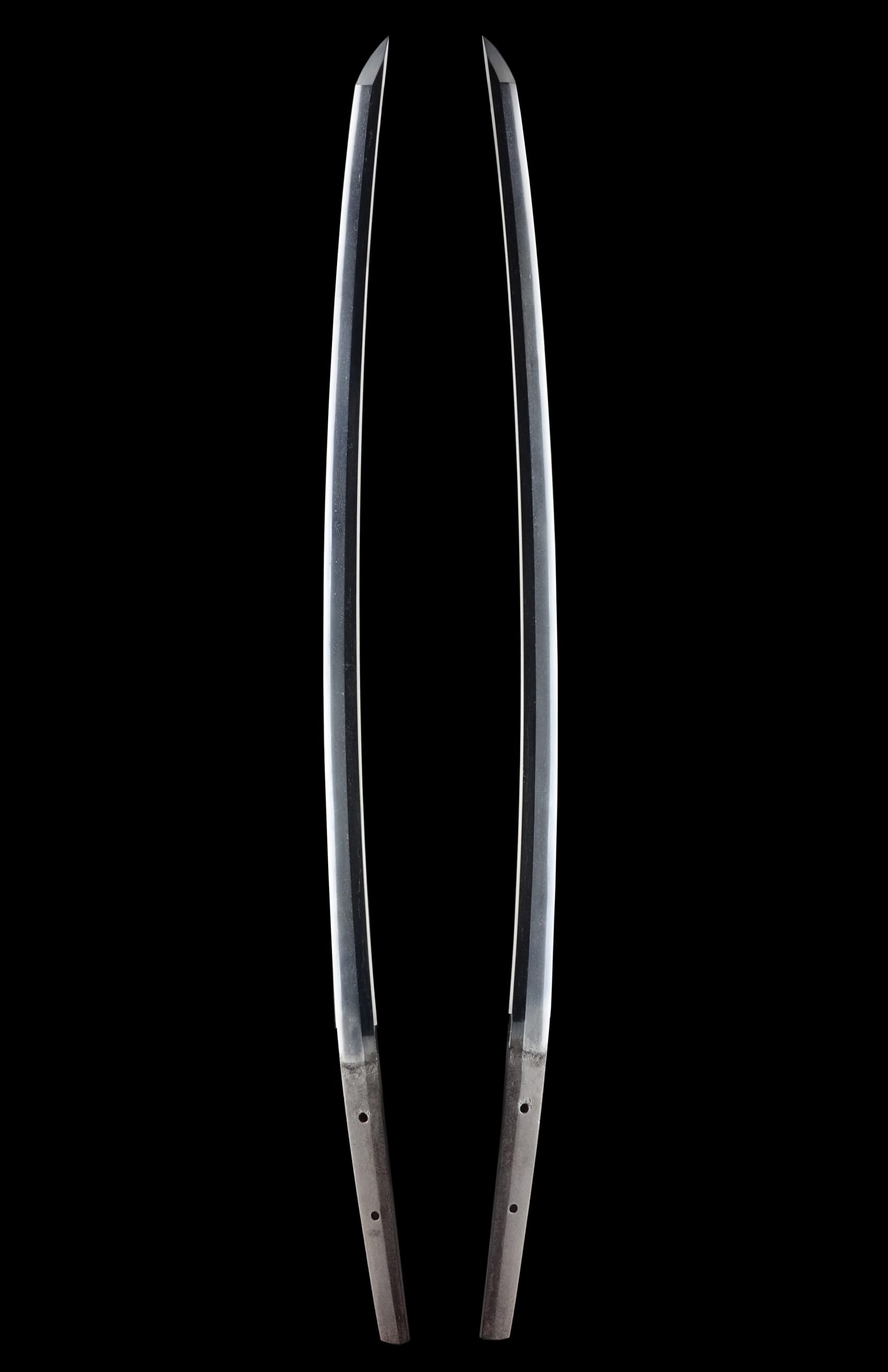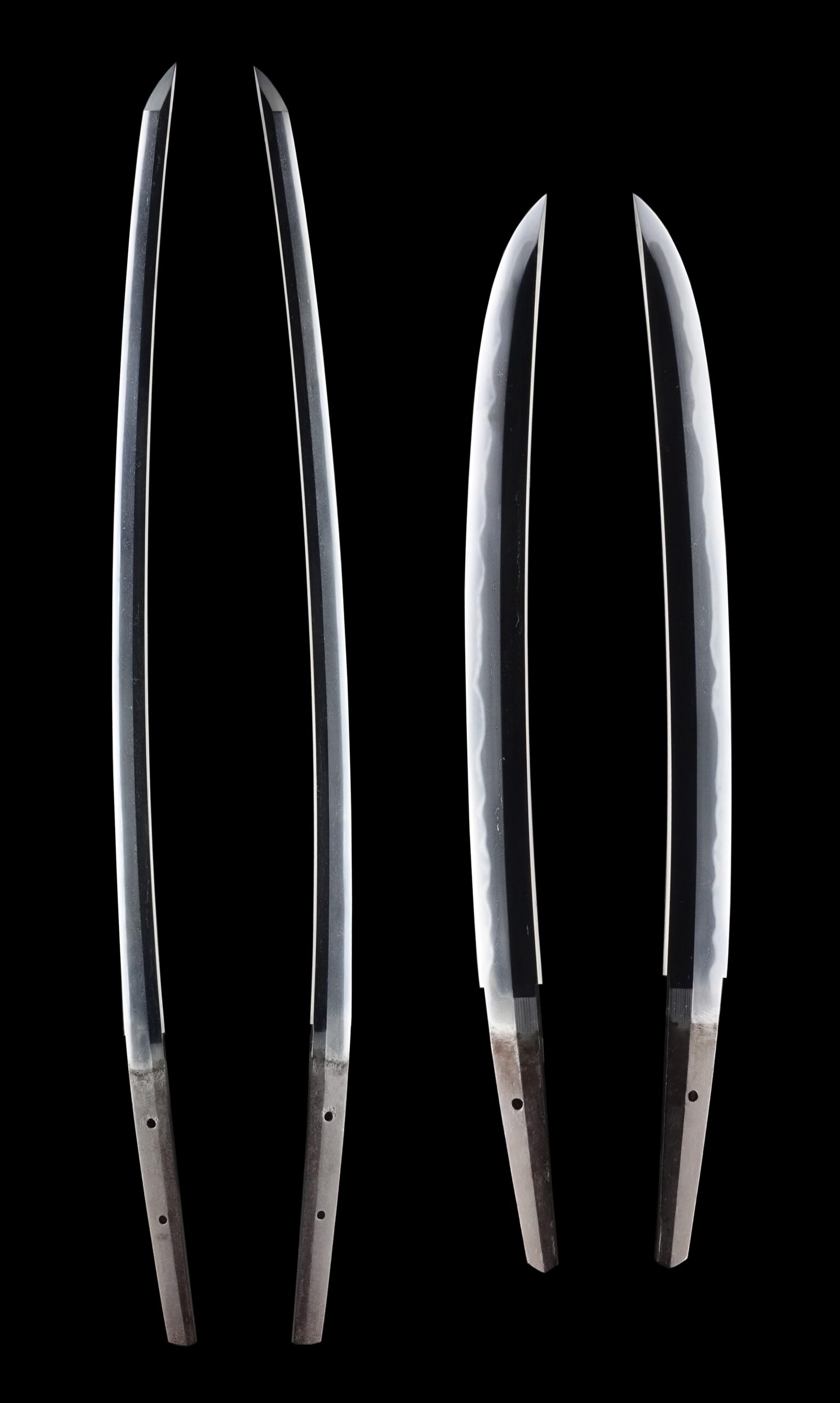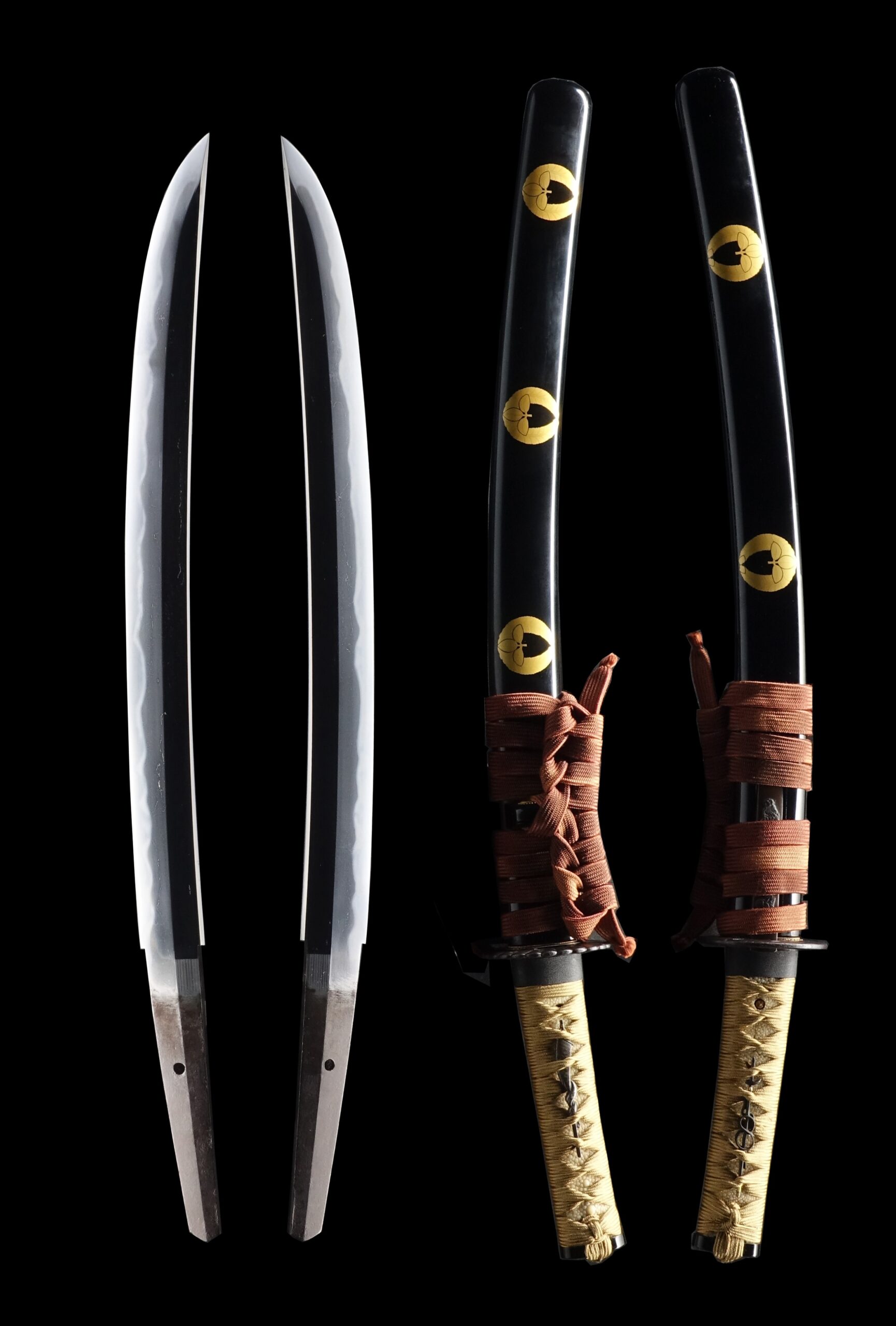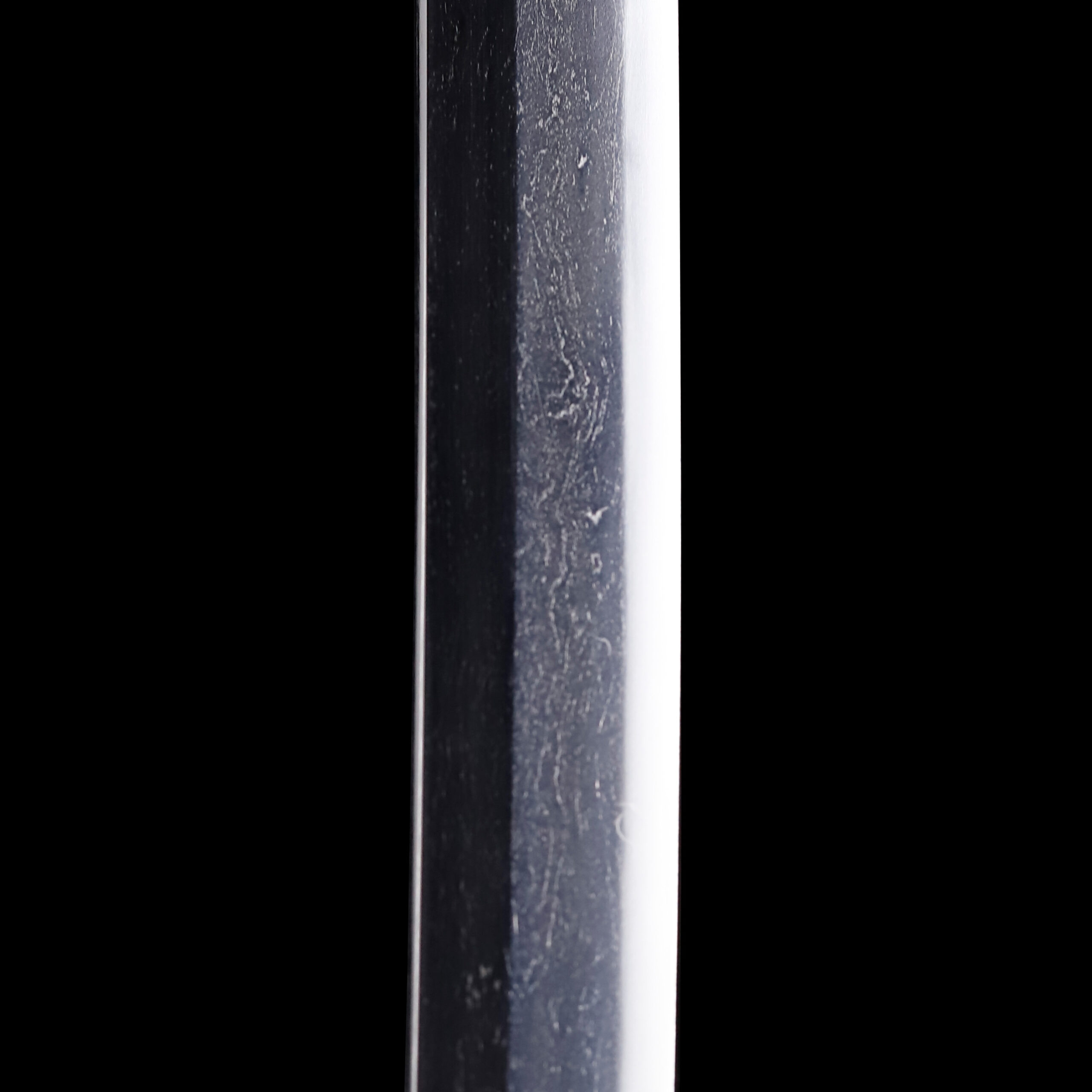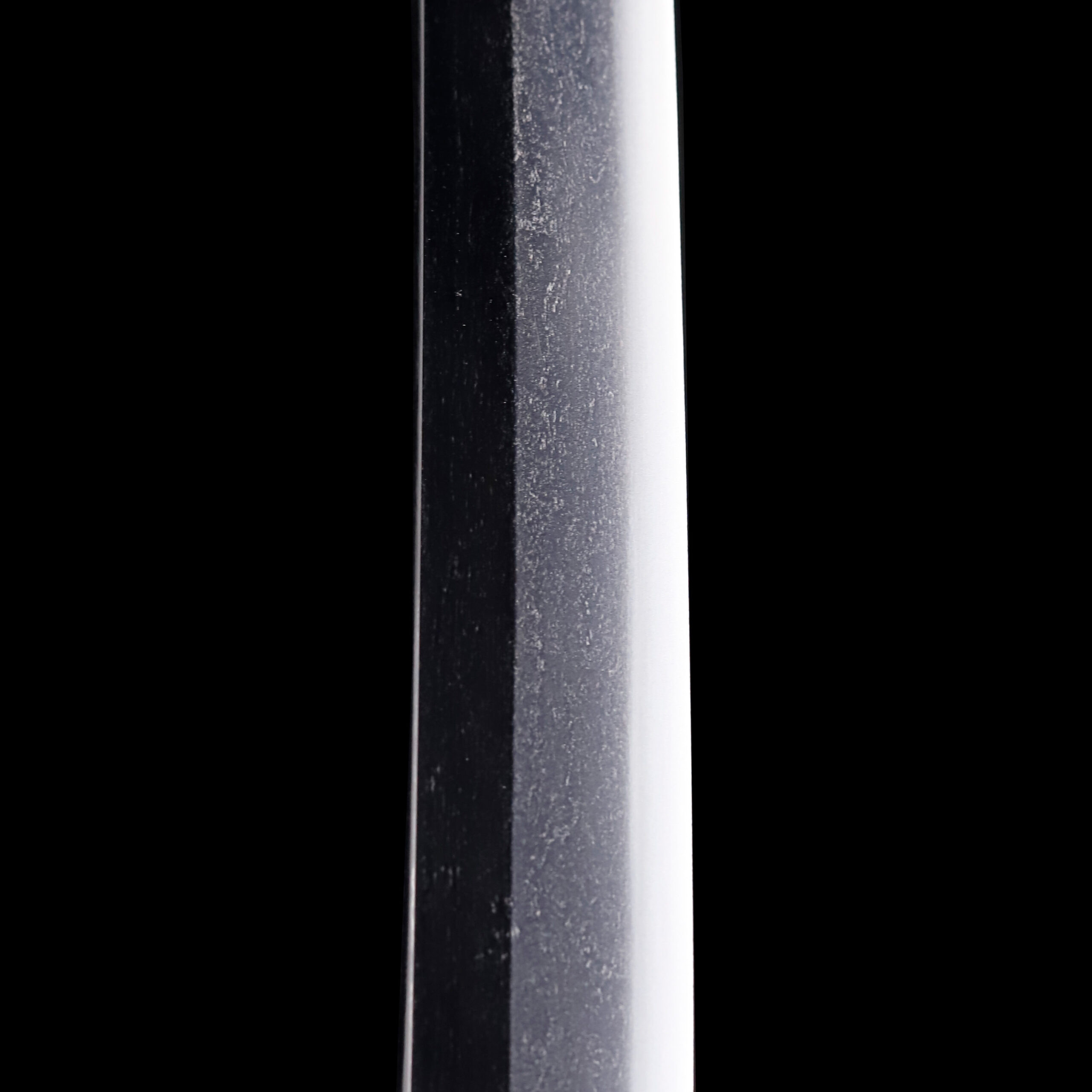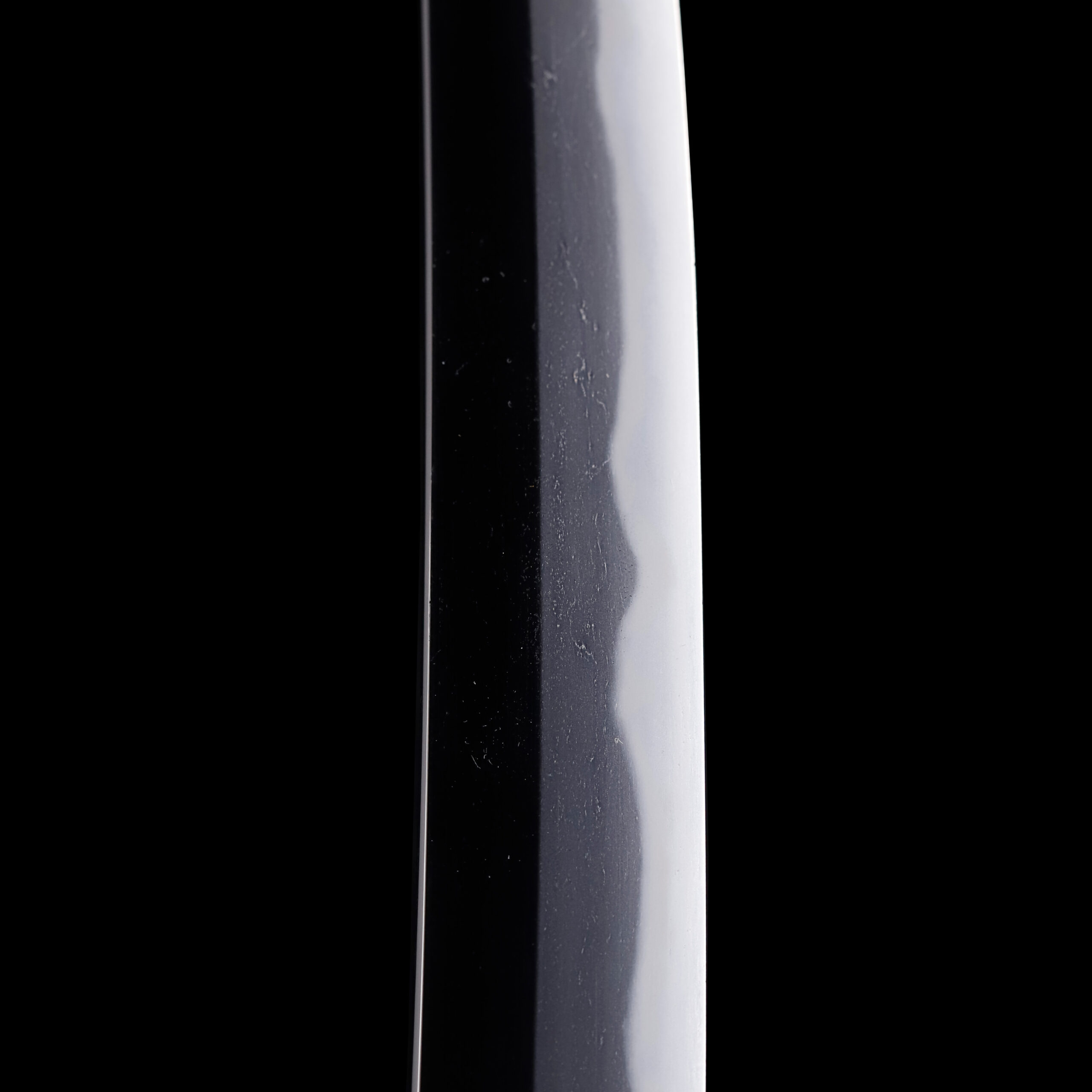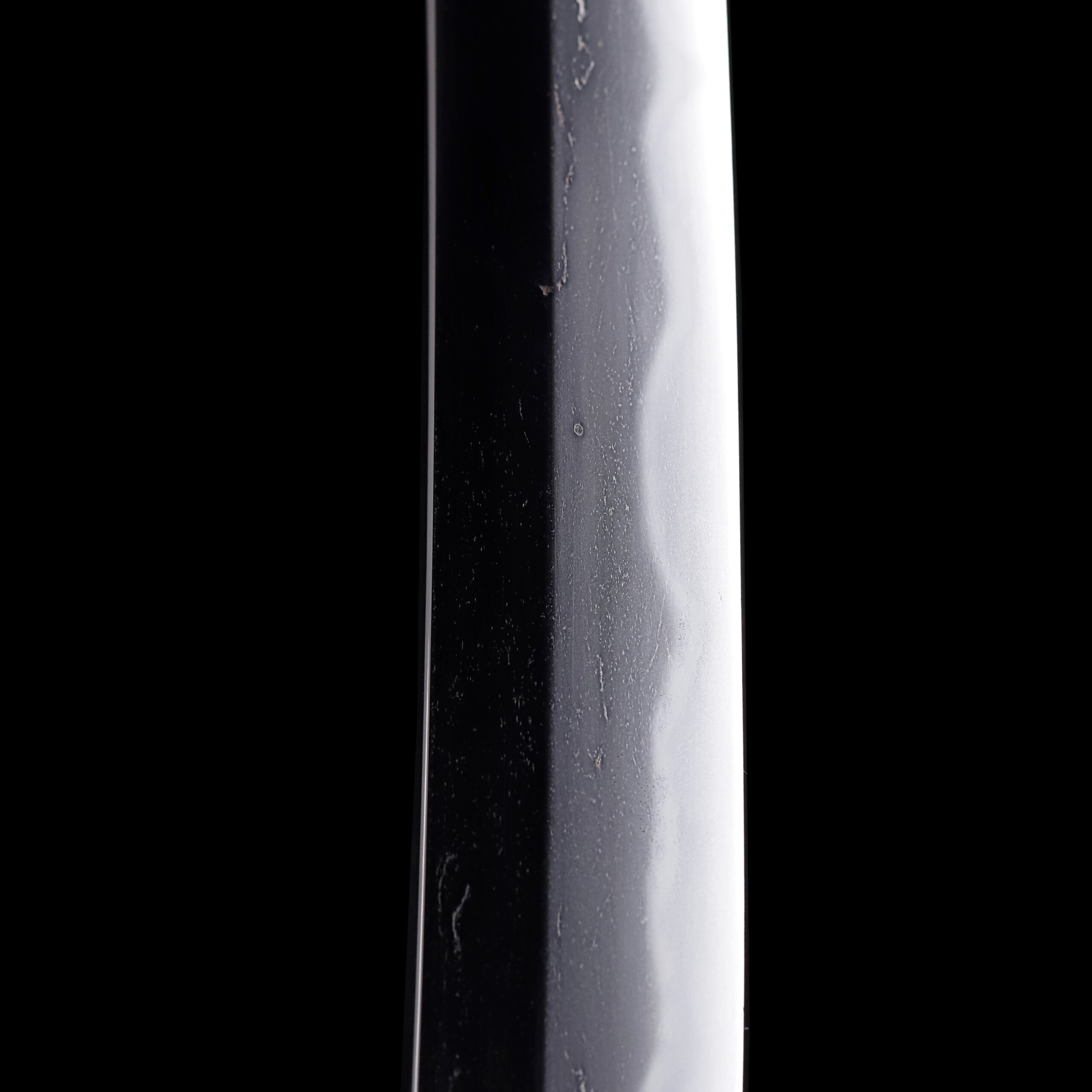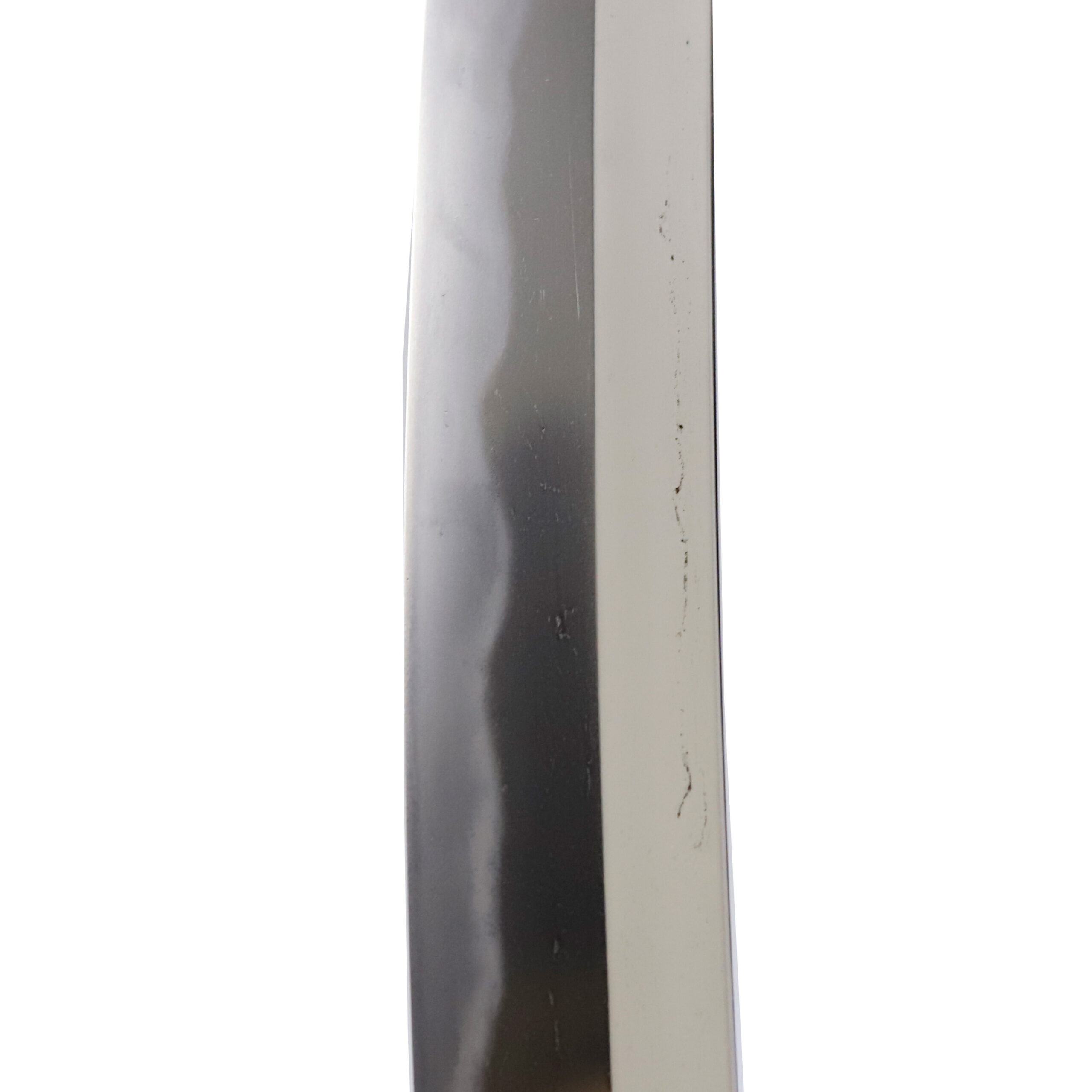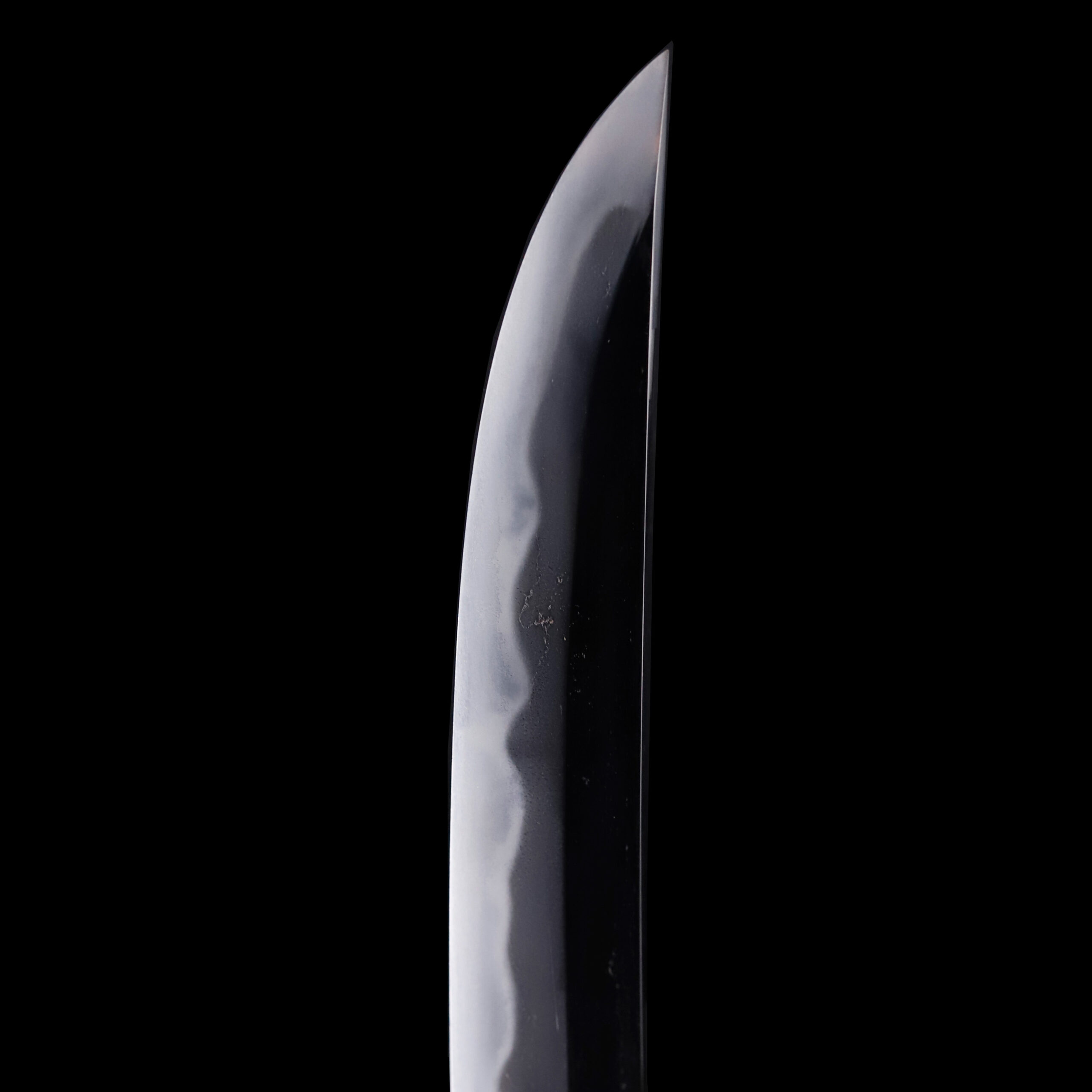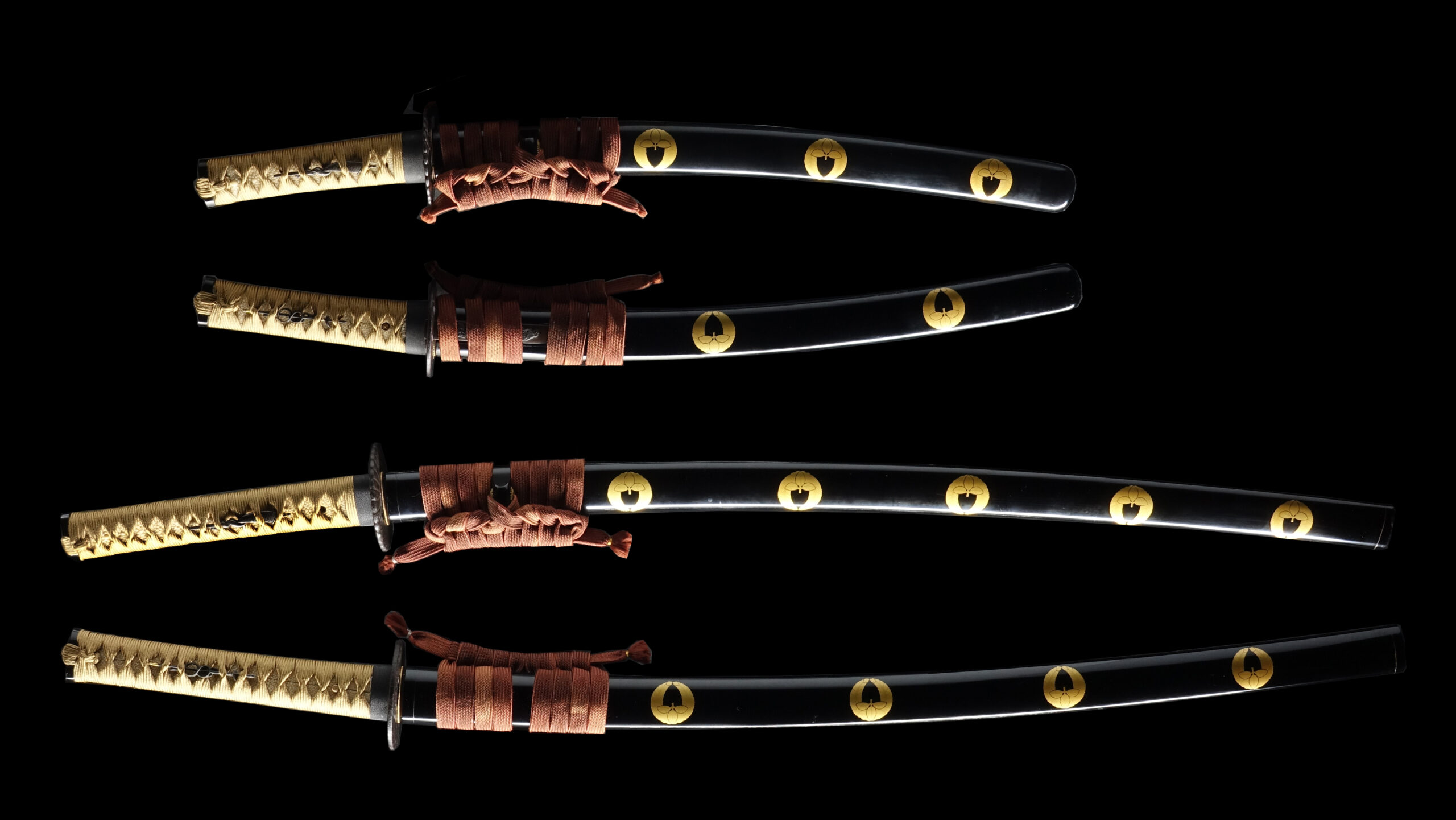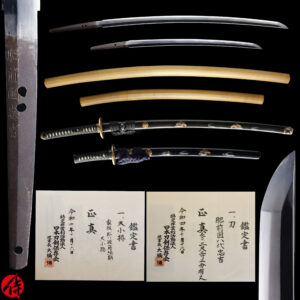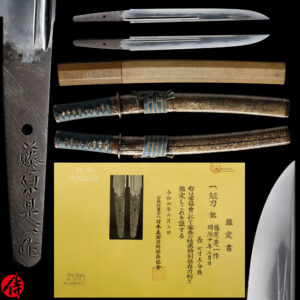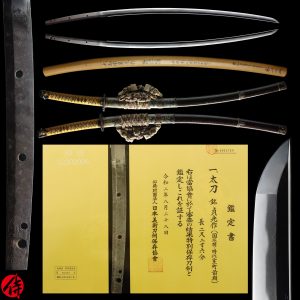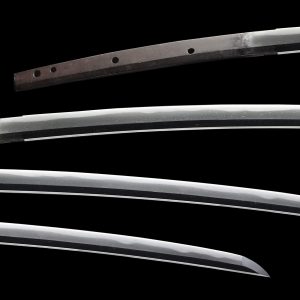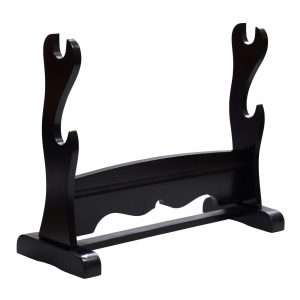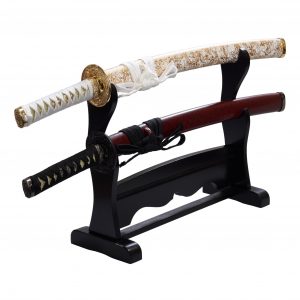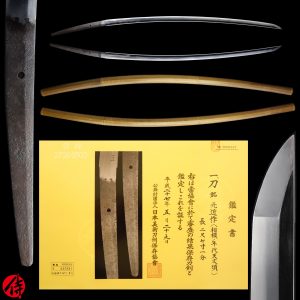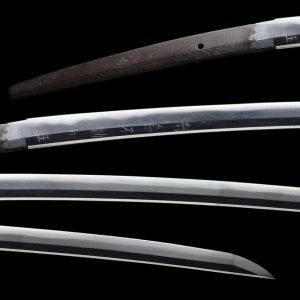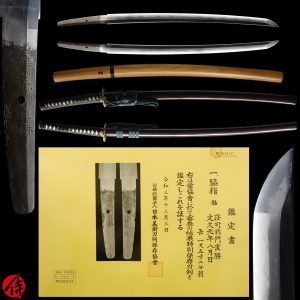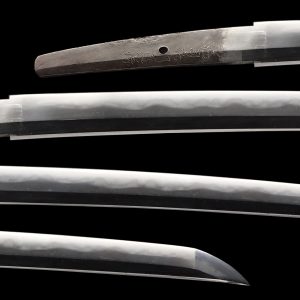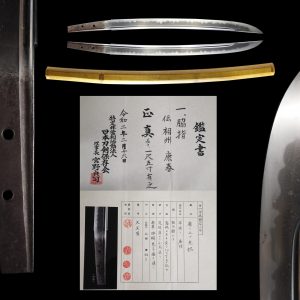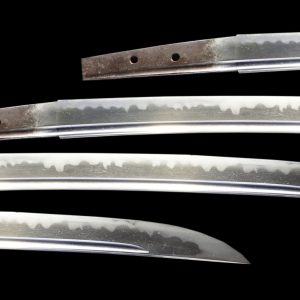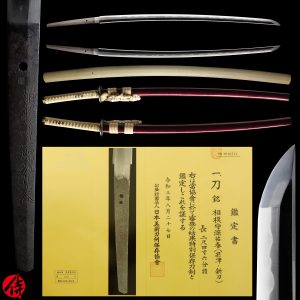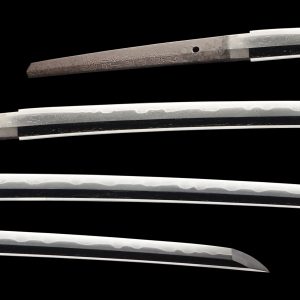Antique Japanese Sword Daisho attributed to Naminohira/Echizen Seki with NBTHK Tokubetsu Hozon Certificate & Hozon Certificate
【Description】
Katana
This Katana is attributed to Naminohira (波平) during the early Muromachi period (Approx. 600-650 years ago), according to its NBTHK’s appraisal. Naminohira(波平) was one of the most influential schools in Satsuma domain (Today’s Kagoshima prefecture), founded by a swordsmith named Masakuni (正國) during the late-Heian period(Late 12th century). The swordsmiths in this school were known for having their name with one of these letters, 行(Yuki) or 安(Yasu). From the late-Heian period until the end of Samurai times(Late 19th century), the Naminohira family had kept the mastership for a thousand years.
The Naminohira swords were cherished among Samurais in the marine army, mainly because the name Naminohira(波平) means “Tides are quiet.” in Japanese. The origin of the name Naminohira dates back to the school’s foundation. It is said that the founder Masakuni was originally from Yamato domain (Today’s Nara prefecture). The legend says he was able to calm the waves by dedicating his sword to the sea when his school in Yamato sailed to settle in Satsuma domain. Since then, he began to use the title “Naminohira Yukiyasu (波平行安)” – “Tides are quiet, easy to go.”
Wakizashi
This Wakizashi was attributed to Echizen Seki (越前関), who was a group of swordsmiths who moved from Mino province (Today’s Gifu prefecture) to Echizen province (Today’s Fukui prefecture) during the Keicho era (1596-1615: Late Azuchi Momoyama-Early Edo period).Echizen Province was prosperous during the Edo period, being ruled by the Echizen Matsudaira clan, a direct retainer of Tokugawa clan who ruled the Edo government. Many skilled swordsmiths moved to Echizen from different regions because of high demand among Samurai who lived there.
The MINO swordsmiths style, also known as MINO-DEN, basically has the TOGARI(Pointed shapes protruding from the Hamon )in a classic straight line and random temper line with some white Utsuri. MINO-DEN had its origin from YAMATO-DEN in the late KAMAKURA period(1280-1330). It flourished in the MUROMACHI period(1333-1573) and continued until the EDO period(1603-1868).
MINO-DEN especially prospered during Sengoku Jidai(Warring State period) due to the high demand for weapons. And the location of Mino province beat others. Akechi Mitsuhide controlled Mino province, and Nobunaga Oda ruled Owari province, and Tokugawa Ieyasu was the lord of Suruga (Neighboring areas). There was high demand from those powerful feudal lords and their retainers. Furthermore, so many wars occurred between the Kanto region and the Kyoto area, and Mino is located in the middle, making feudal lords feel convenient to order swords from MINO-DEN. The blades forged in MINO provinces also had the reputation of their practical design and sharpness. Many feudal lords demanded swords forged in the Mino province. Also, many swordsmiths in Mino province moved to other areas of Japan like Echizen Seki swordsmiths by being hired by feudal lords.
*Please keep in mind that there are a couple of visible Kitae Kizu on the Wakizashi.
What is Daisho?
Daisho is a pair of two Japanese swords Samurai carried. During the Edo period, having Daisho in public places was considered social status for Samurai. Furthermore, Samurai were required to wear them under the law back then. Daisho is written as 大=Big and 小=Small. Dai part means Katana, and Sho part means Wakizashi. They have such a fancy appearance that we believe a high-ranked Samurai owned them. We are confident you would like this pair of Daisho Koshirae. And based on the style of the sword mounting, they are categorized as DENCHU KOSHIRAE(Sword mountings for entering a castle), which is very formal style of the mountings.
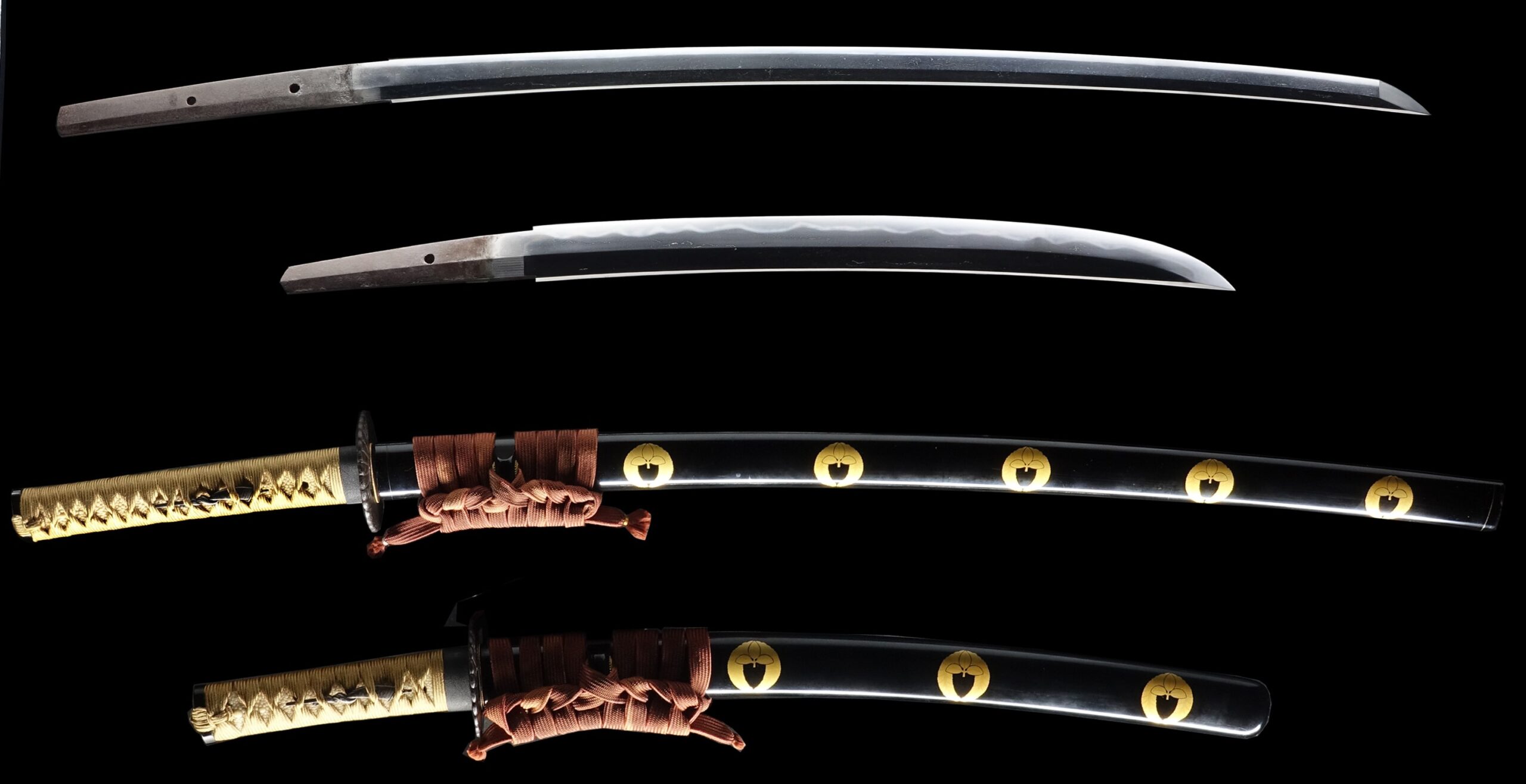
Appraisal
This Katana blade is appraised as a Tokubetsu Hozon Token(特別保存刀剣) and this Wakizashi is appraised as a Hozon Token (保存刀剣). They were issued by NBTHK(Nihon Bijutsu Touken Hozon Kyokai:日本美術刀剣保存協会). These authentication papers were only given to authentic Japanese swords well preserved and high quality with artistic value.
【 Blade】
-Katana
Cutting Edge Length(Nagasa): 62.9 cm (24.7 inches)
Curvature(Sori):1.6 cm (0.63 inches)

-Wakizashi
Cutting Edge Length(Nagasa): 35.9 cm ( 14.1 inches)
Curvature(Sori):0.8 cm ( 0.31 inches)

Hamon:
The crystalline structure which forms along the cutting edge of a blade as a result of the hardening process
Jimon(Jihada):
visible steel surface pattern created by folding and hammering during forging process
-Katana
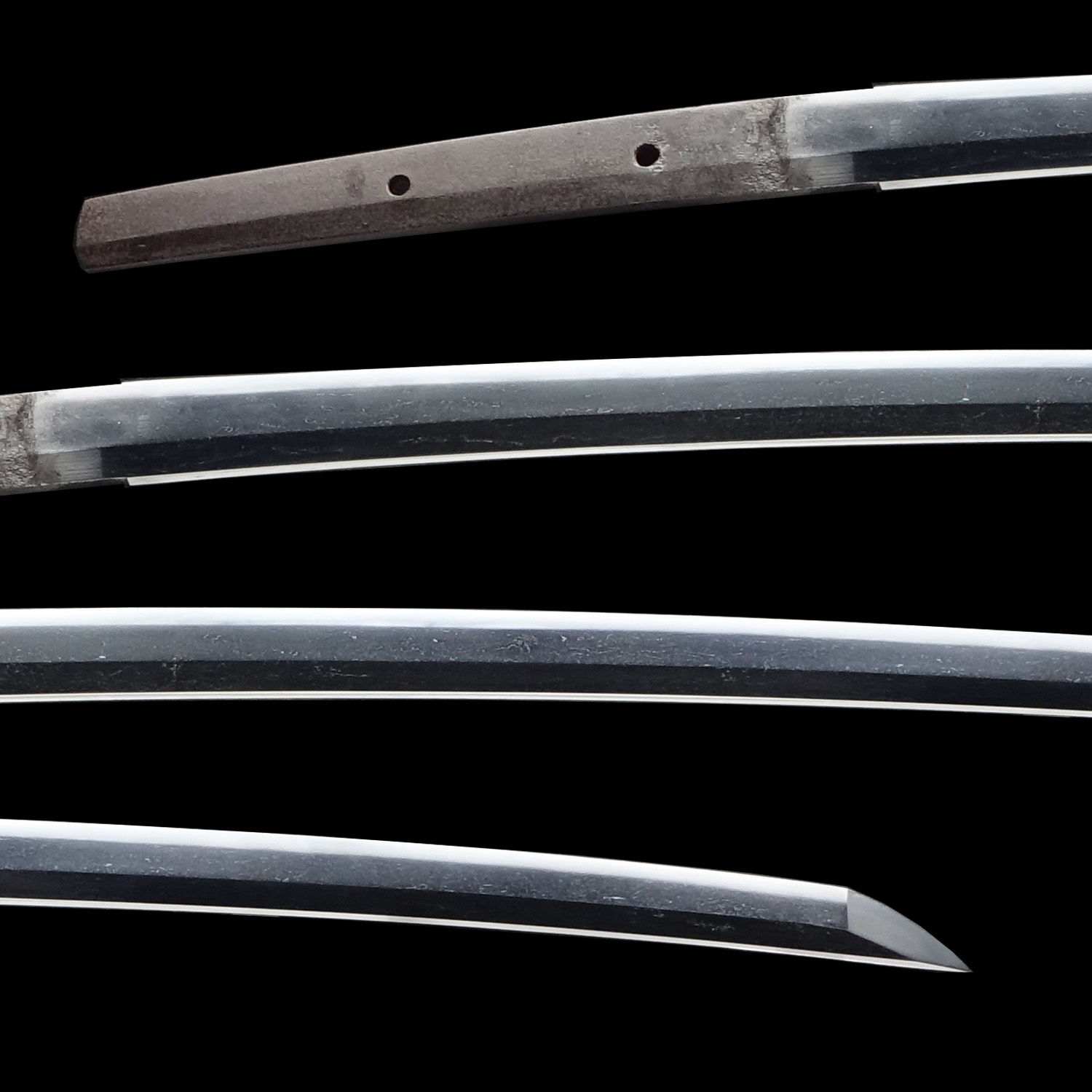
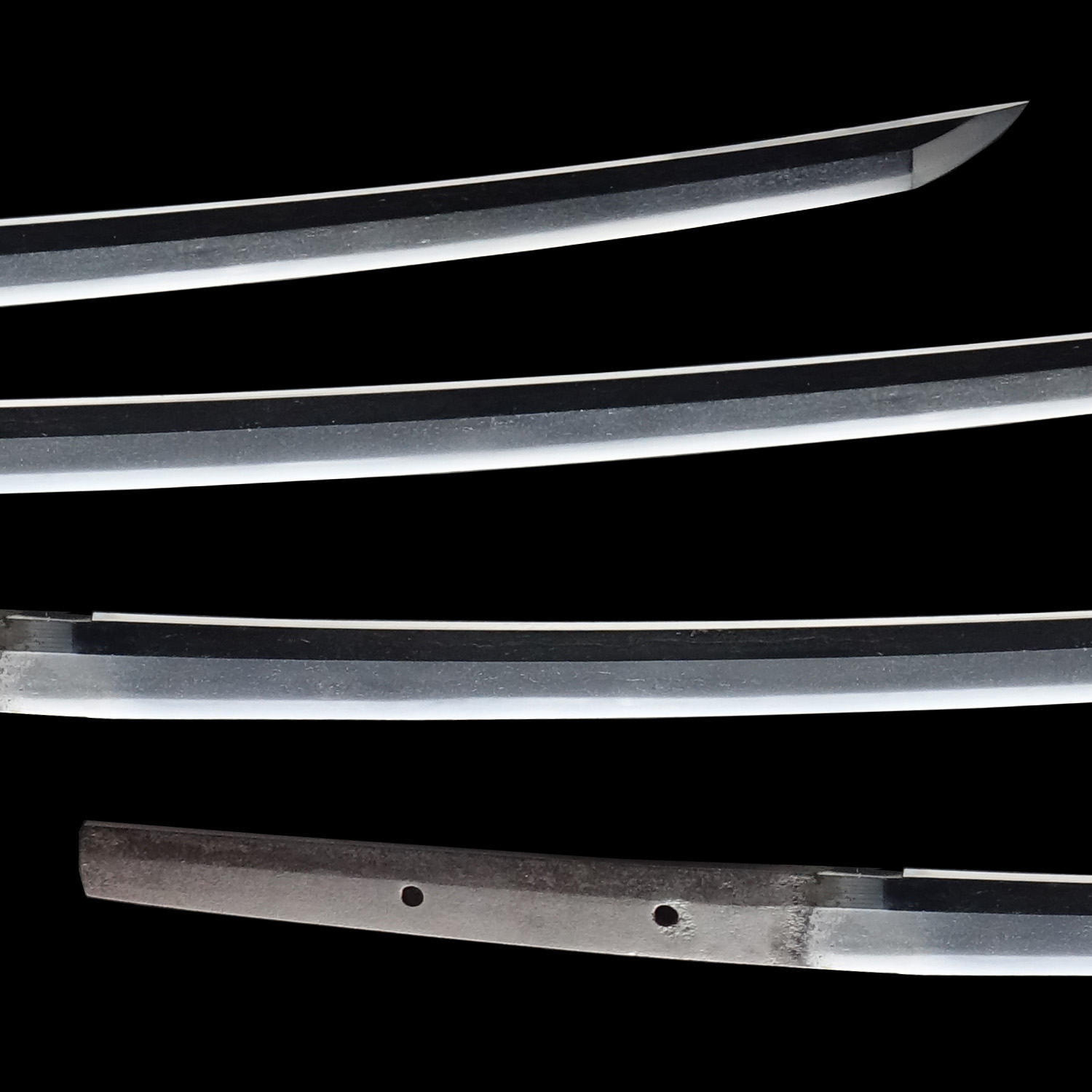
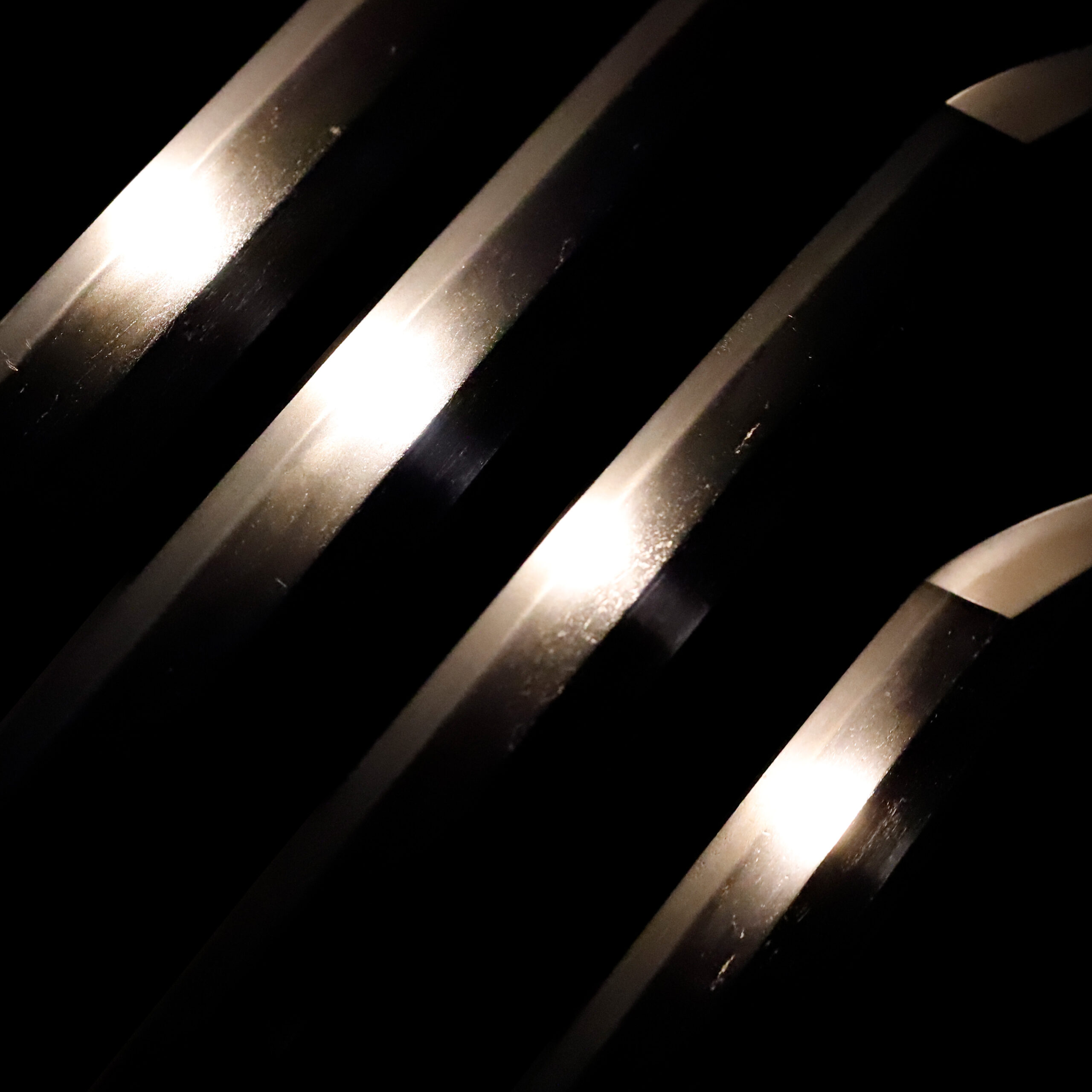
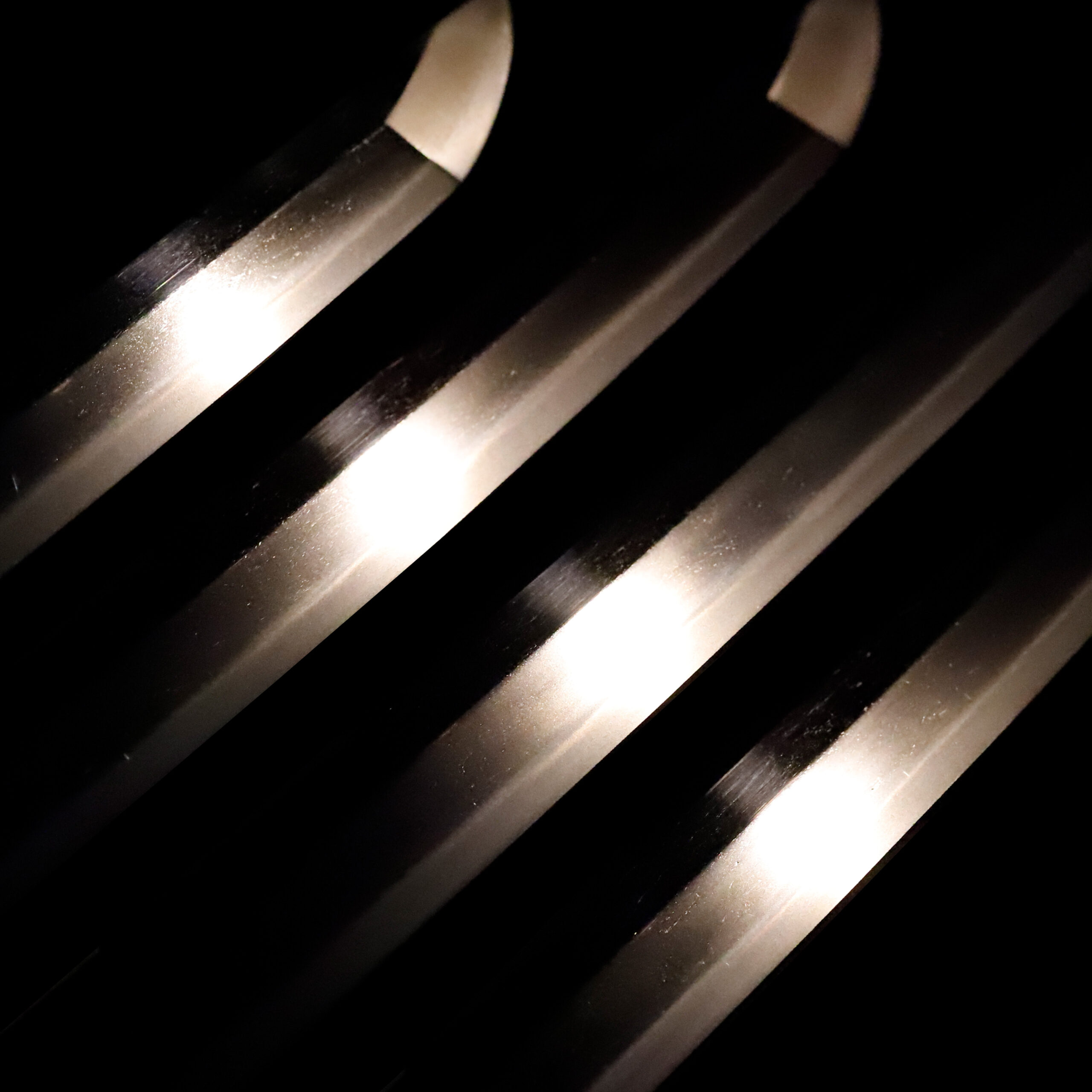
-Wakizashi


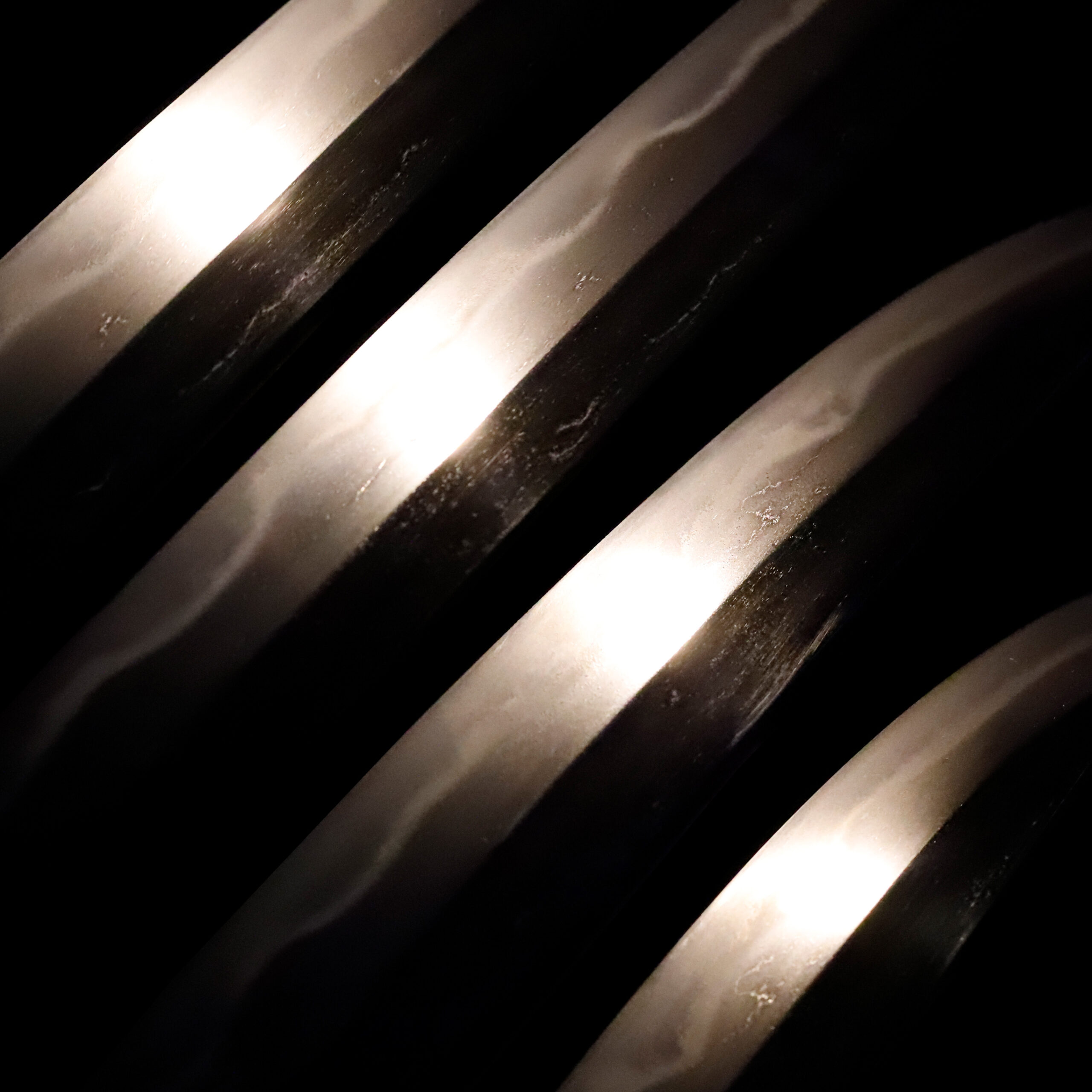
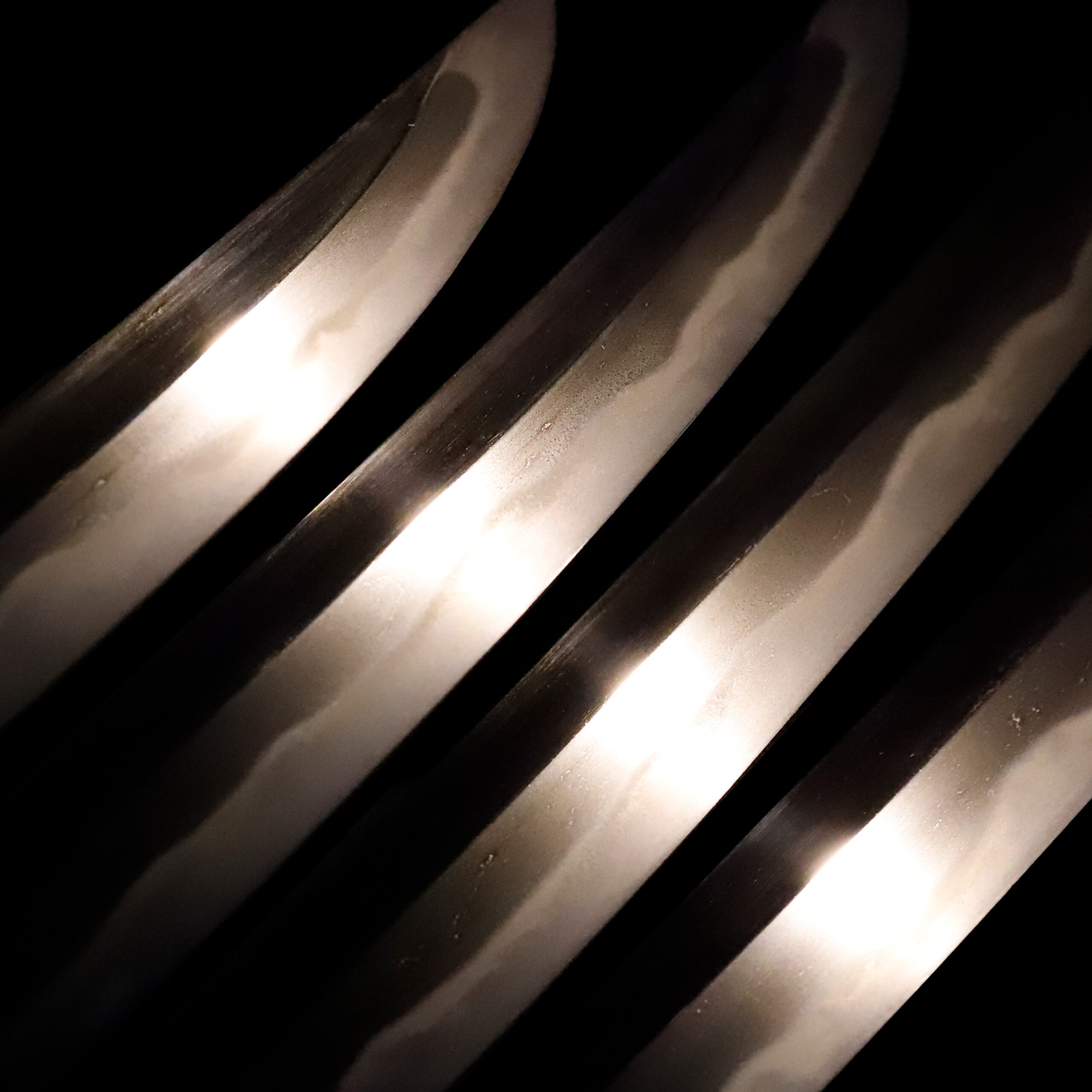
Nakago:Nakago is the tang of the Japanese sword.
Japanese swordsmiths left the black rust on the tang because it prevents red rust while the tang is in its handle. And the discoloration of the tang was created over time, and it is a great indicator for a Japanese sword specialist to estimate when the sword was forged.
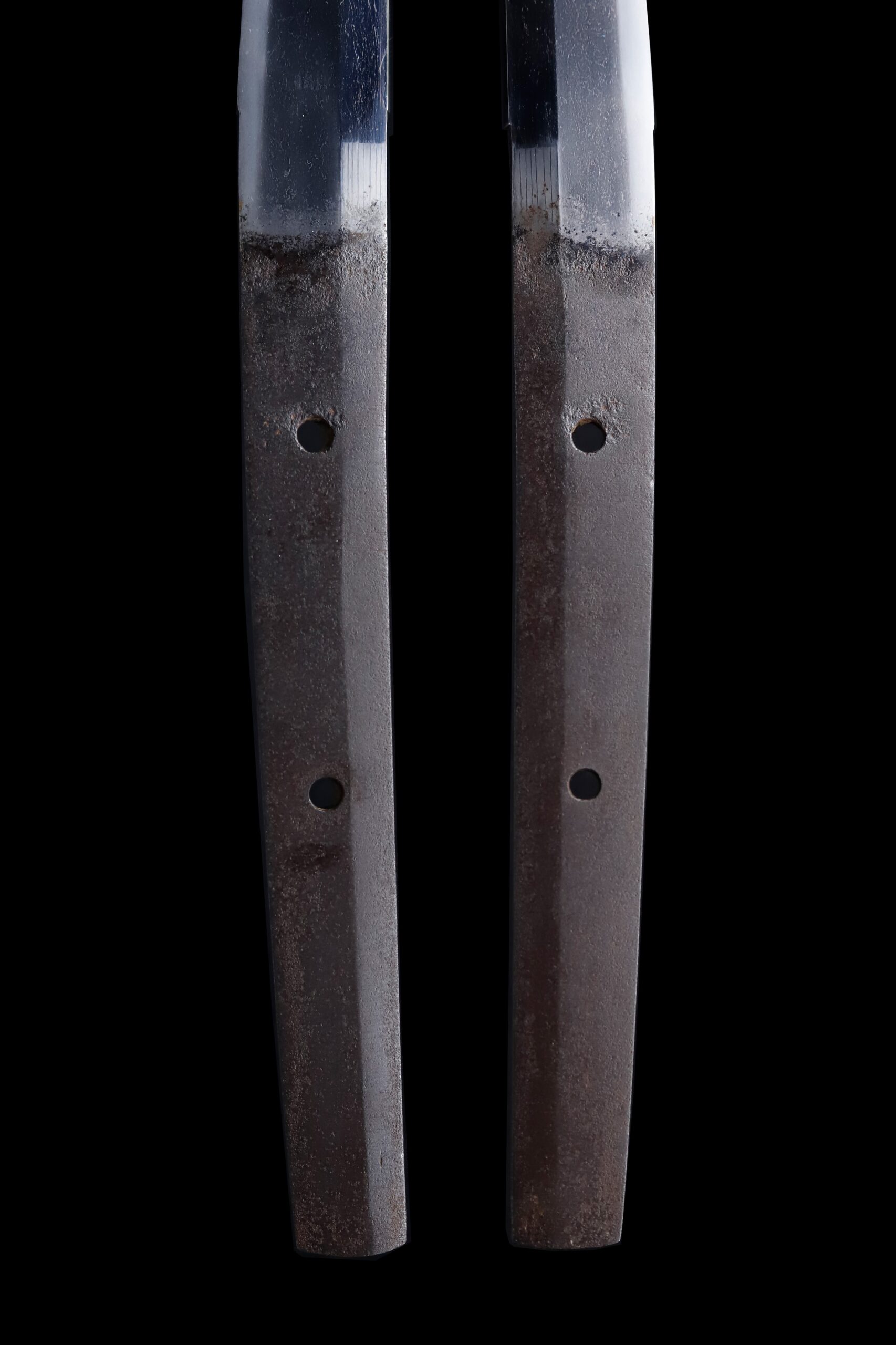
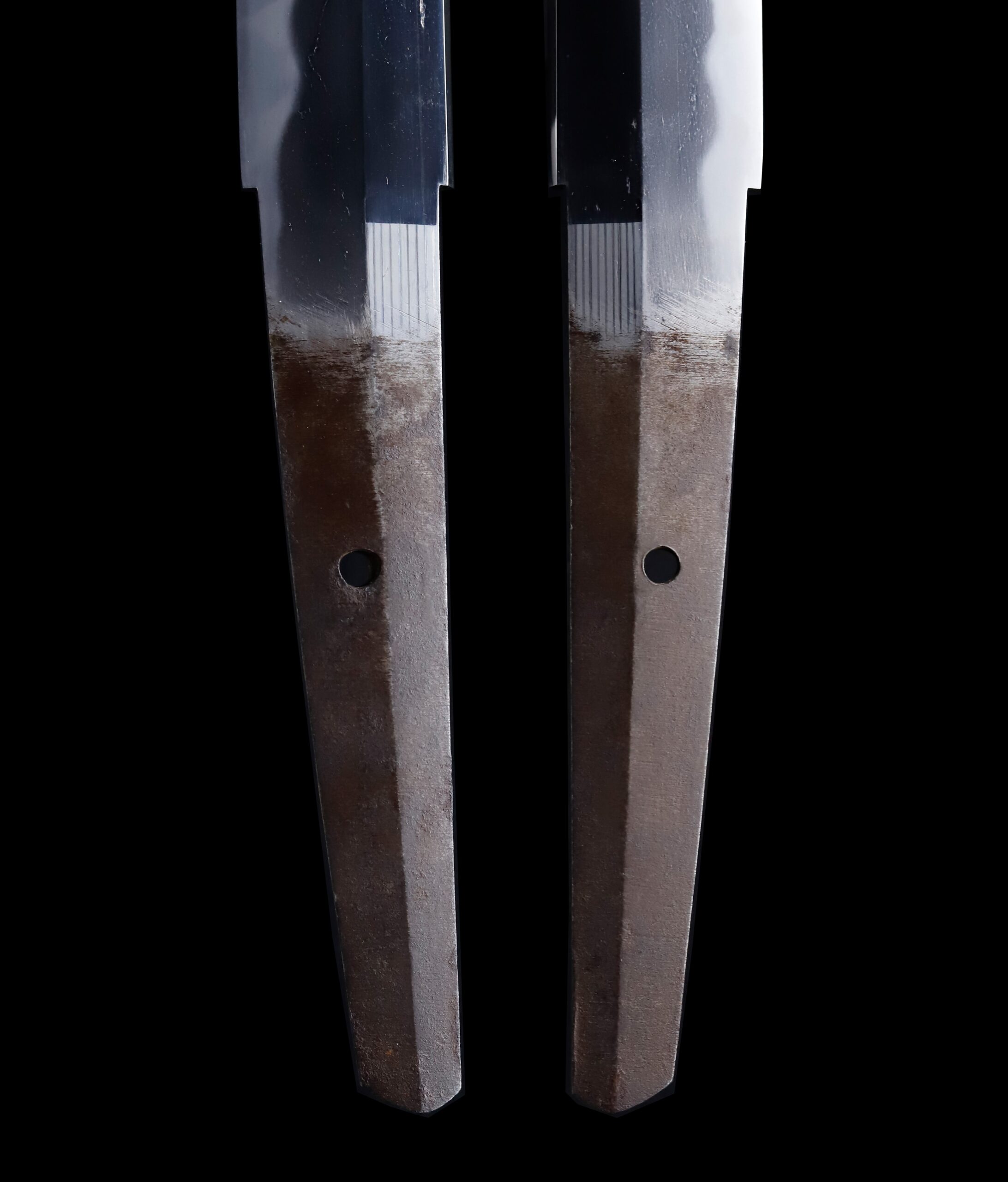
Koshirae: Koshirae is the mounting of the Japanese sword. There are several parts that consist of Koshirae such as Saya(Sabbard), Tsuka( Handle), Tsuba(Handguard).

Fuchi-Kashira:A pair of matching sword fittings that cover the upper and bottom parts of its sword hilt.
This Fuchi Kashira has a simple look. The Kashira part is made of buffalo horn and colored with black lacquer. On the other hand, the Fuchi part is decorated with the Nanako-Ji (魚子地) technique. By striking with a Nanako-Ji Tagane (魚子地鏨, a chisel uniquely used for this process), uniform unevennesses were created on the surface.
There is a Koshirae named the Ban Zashi (番指), which is also called the Kamishimo Zashi (裃指) or the Denchu Zashi (殿中指). About its alias Denchu Zashi, the word Denchu (殿中) refers to the Shogun (将軍, General)’s residence. When entering the castle, Samurai left their Daito (大刀, long sword; Katana) at the entrance and carried only short swords. They inserted their swords in such a way that they could not cut the opponent at the same time as the sword was drawn.
We believe this Daisho Koshirae could be categorized as the Ban Zashi Koshirae. The handle is wrapped with stingray skin, and Menuki is often made from luxurious materials such as gold. In this style of Koshirae, the scabbard has finished with black lacquer. Furthermore, the Fuchi Kashira also matches the one used in this Ban Zashi Koshirae’s construction.

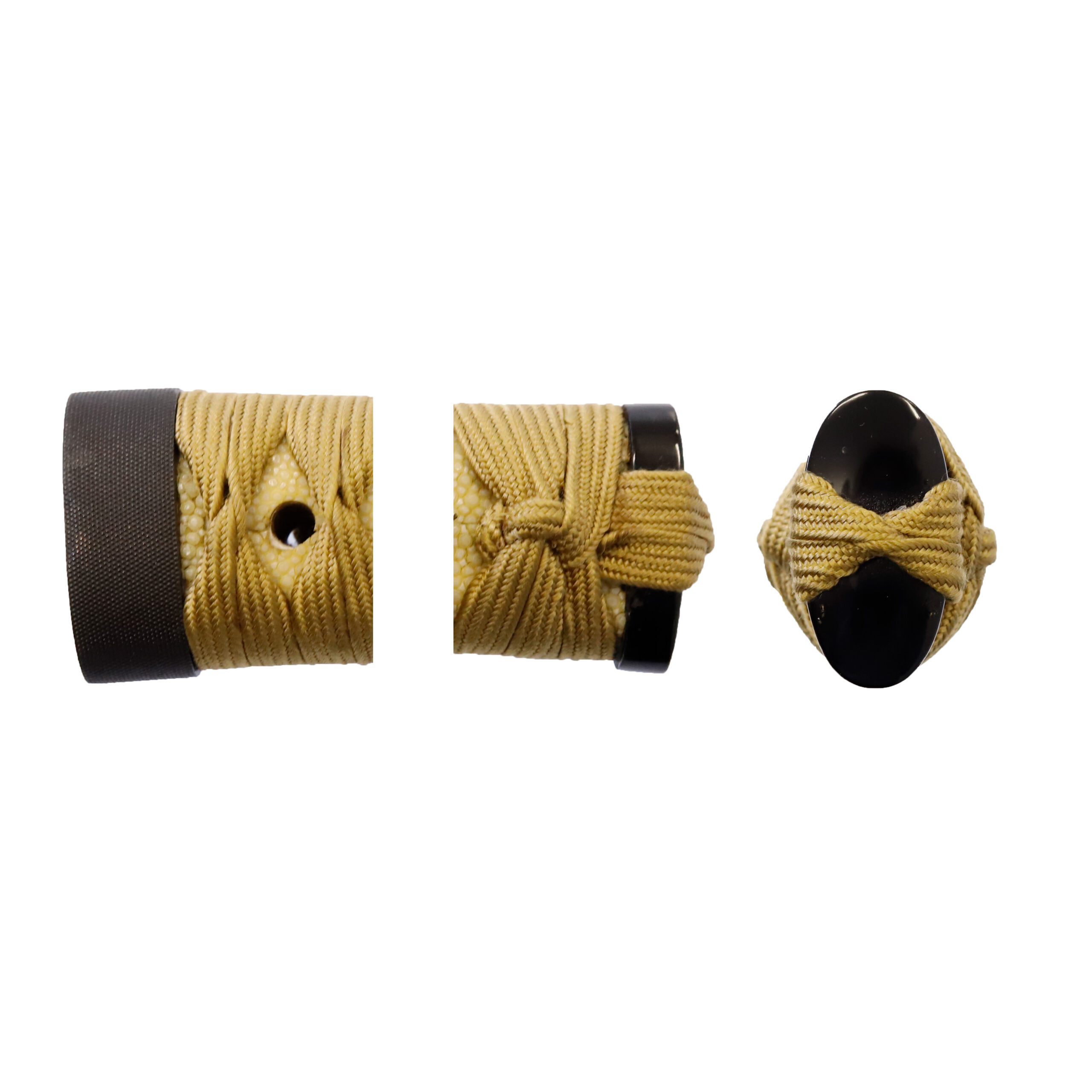
Tsuka and Menuki:Tsuka is the handle of the Japanese sword and Menuki is its decoration.
The motifs of these Menukis are Samurai-related tools. One side is the Yari (槍, spear), and the other side is the Hata Jirushi (旗印, banner). The Yari is once one of the primary weapons for Samurai warriors. A spear has a long, thin handle, and a sword is attached to the tip. As the battle format shifted from cavalry battles to foot battles and from individual battles to team battles, spears came to be used more than Naginata (薙刀, different type of long weapon) and widespread.
The Hatajirushi is a military flag used on battlefields. The Hata Jirushis reflected the thoughts and worldviews of military commanders; therefore, there were various designs for Hata Jirushis. In this work, we can see that horizontal stripes are drawn on the top of the flag. Although it has now peeled off due to aging, we estimate that these flags were initially painted in gold and silver.

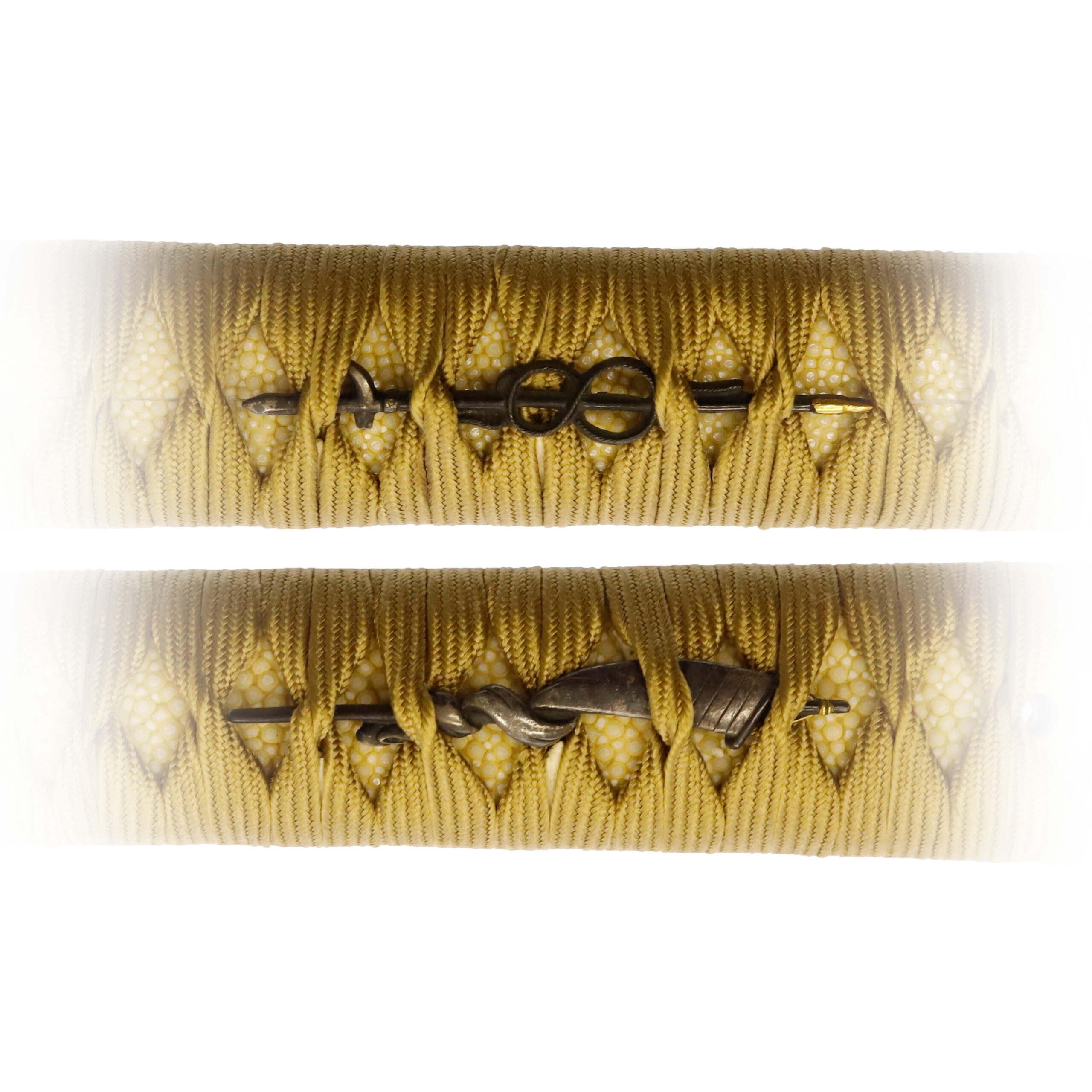
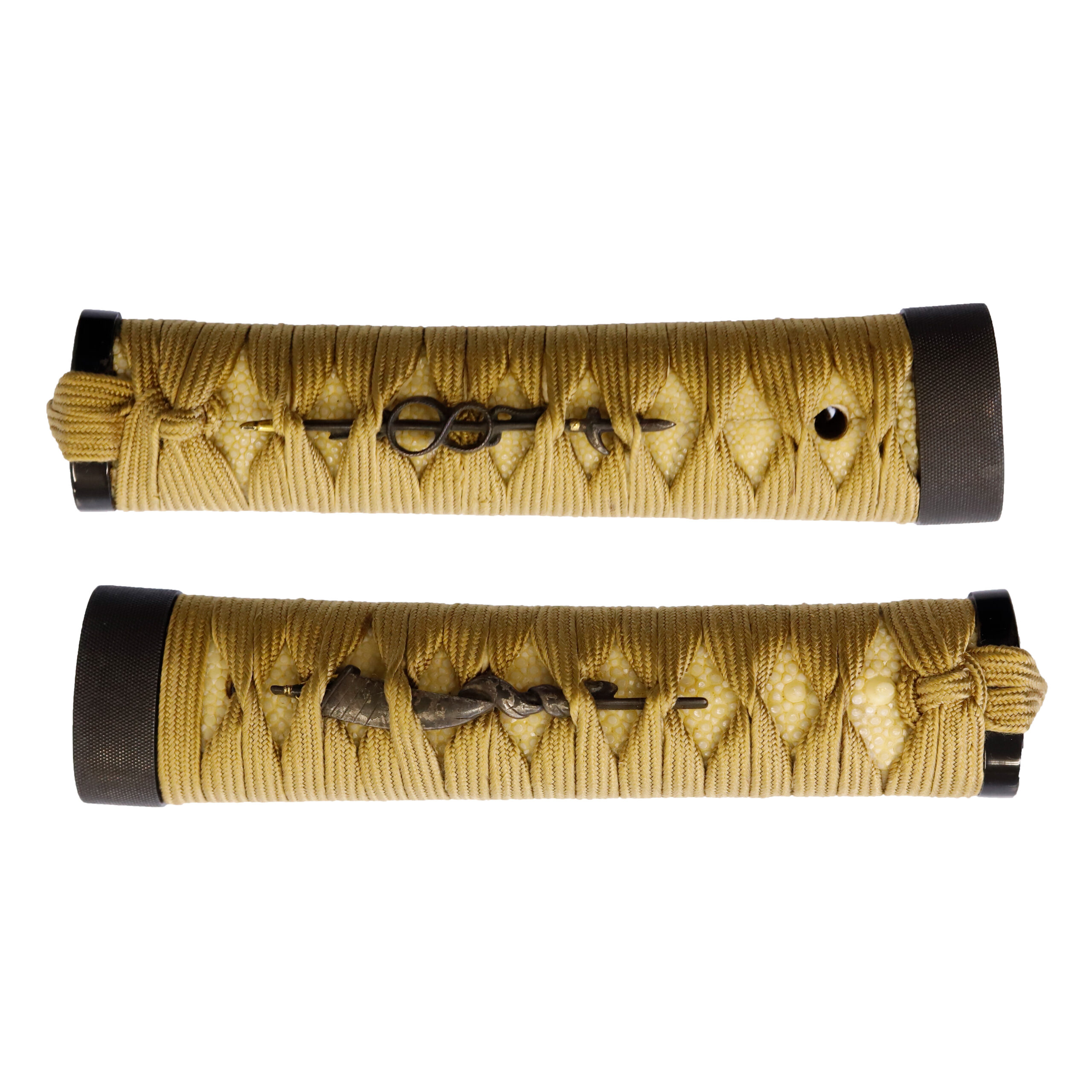
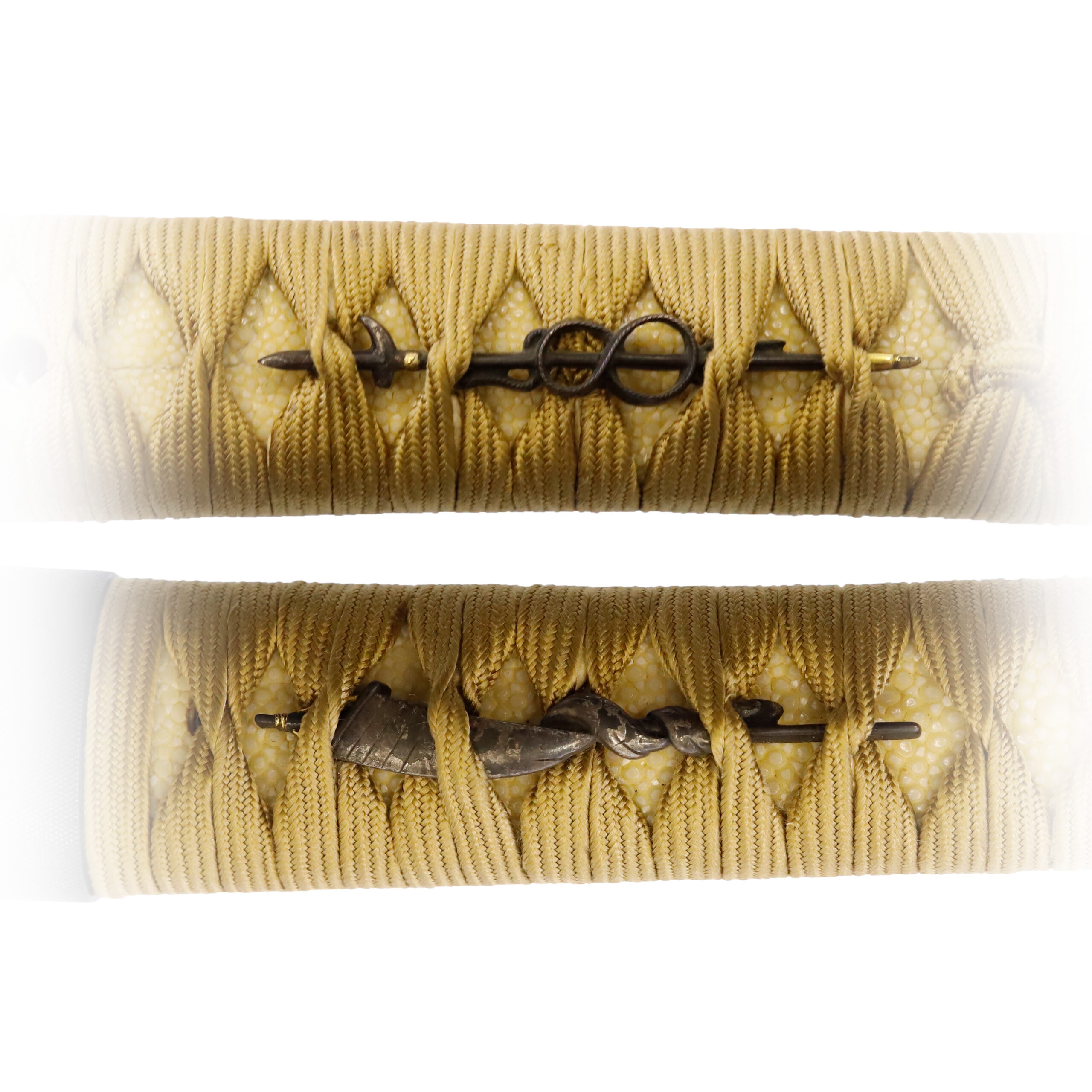
Tsuba and Habaki:Tsuba is the handguard for the Japanese Sword and Habaki is the equipment to make the blade not touch its scabbard inside. It prevents the blade from getting rusty and chipped.
These Tsubas have the Kikuka (菊花, chrysanthemum flower) shape. The whole forms imitate chrysanthemum petals, and a leaf is engraved on each side. It is a stylish composition in which a part of the leaf is superimposed on the flower. It seems both Tsubas are made from iron. You could enjoy the color and texture of iron that has passed the long years. This flower design is often seen in sword mountings. A long time ago, the chrysanthemum was used as a medicine for obtaining a long life in the continent, and it was brought to Japan with this thought in the Nara period (648-781). The chrysanthemum symbolizes autumn, and people have greatly appreciated it since ancient times. As its petals form radially, the chrysanthemum has been likened to the sun. That is why this flower pattern is treated as the symbol of perpetual youth and longevity or good health.
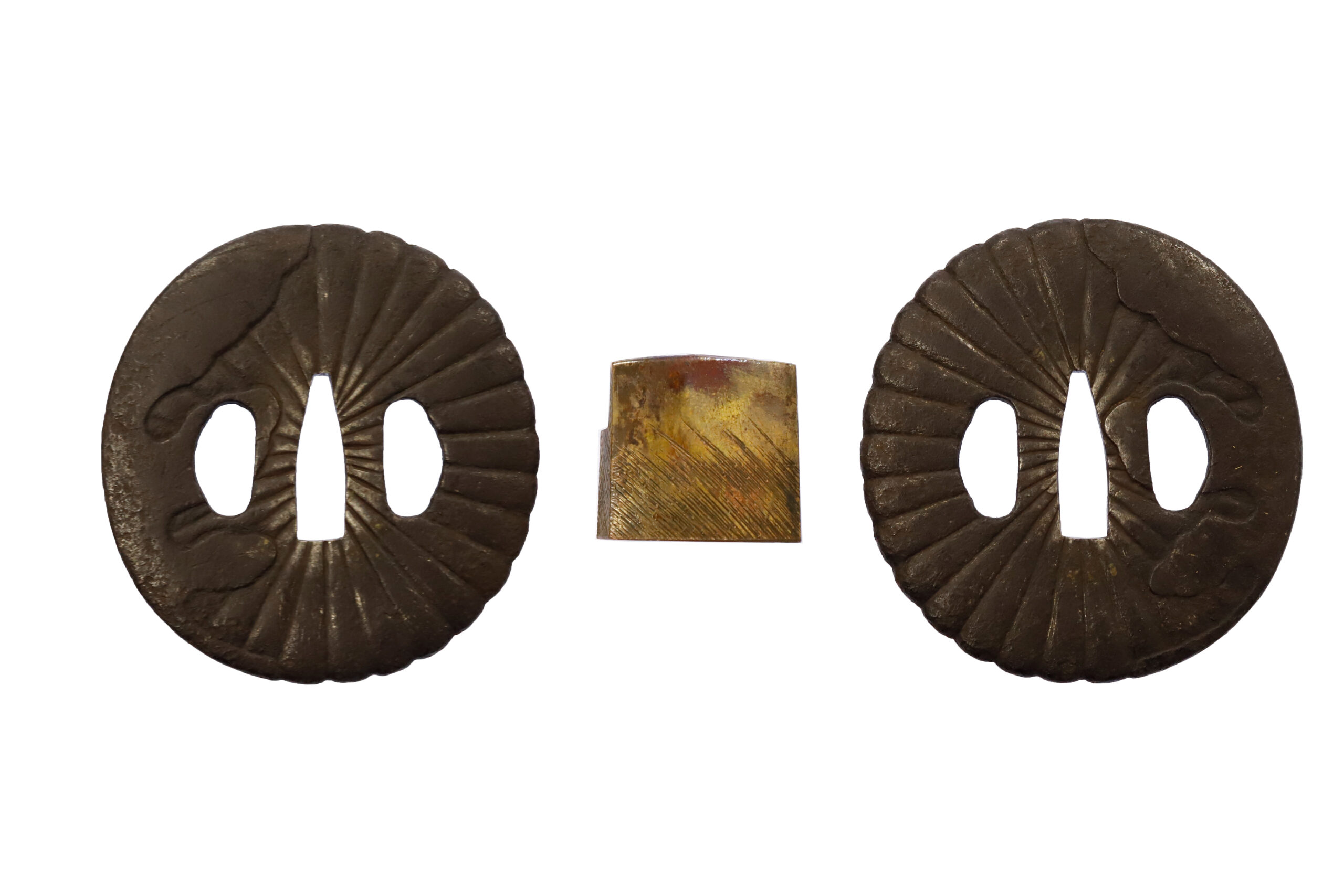
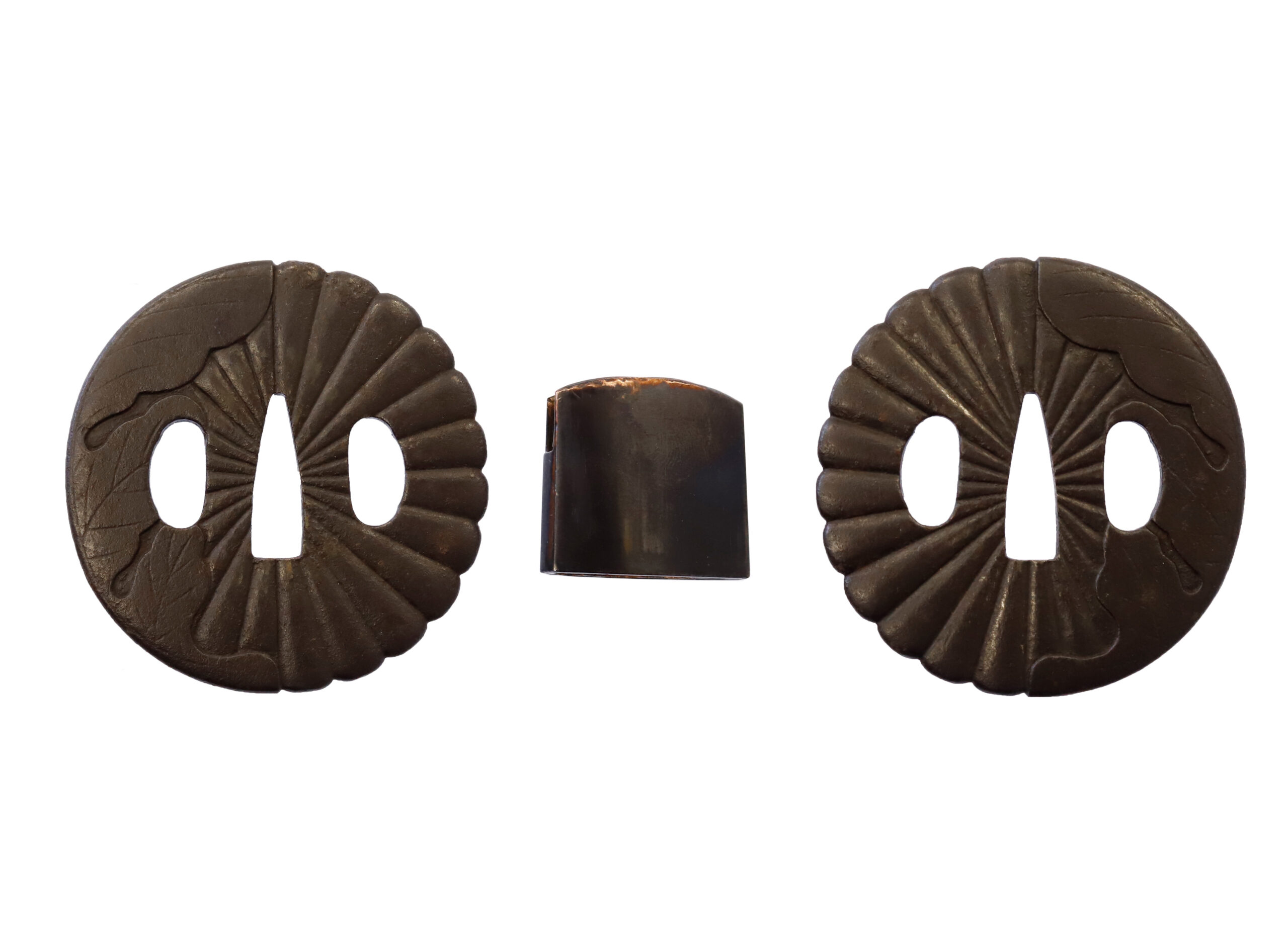
Saya: Saya is the scabbard for the Japanese sword.
These scabbards are colored with elegant black lacquer. You would find golden circle-shaped marks on these scabbards, and all of them are the same pattern. We believe this design is a family crest called the Sagari-Fuji (下り藤). It is a kind of Fuji (藤, wisteria) pattern. Since wisterias have strong fertility and grow being entwined with other trees, people regarded this flower as a symbol of longevity and prosperity for future generations.
Also, its Japanese name Fuji (藤), is likened to another word Fushi (不死), which means immortality. According to a theory, that is why the Fujiwara (藤原) family, who reached the height of glory in the Heian period (794-1185), used this motif for their family name and family crest. It is said there were Samurai families who used Fuji-designed family crests due to the admiration of the Fujiwara clan, which once occupied most of the upper aristocrats. Also, it might be because they wanted to share the prosperity of the Fujiwara clan. This trend possibly influenced the Sagari-Fuji pattern of these scabbards.

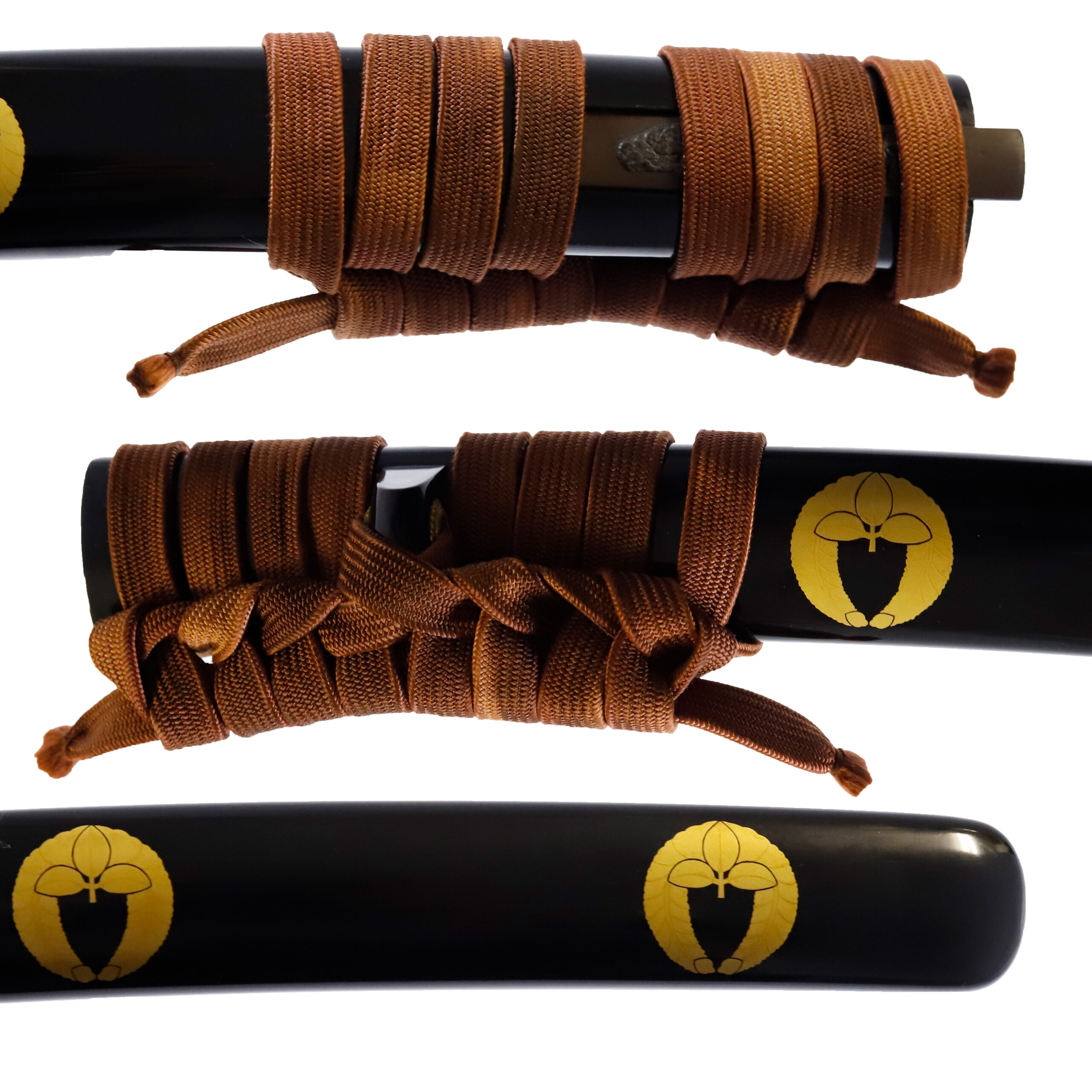
Kozuka:Kozuka is a small knife stored in Kozuka Hitsu (groove of the sheath of the Japanese sword).
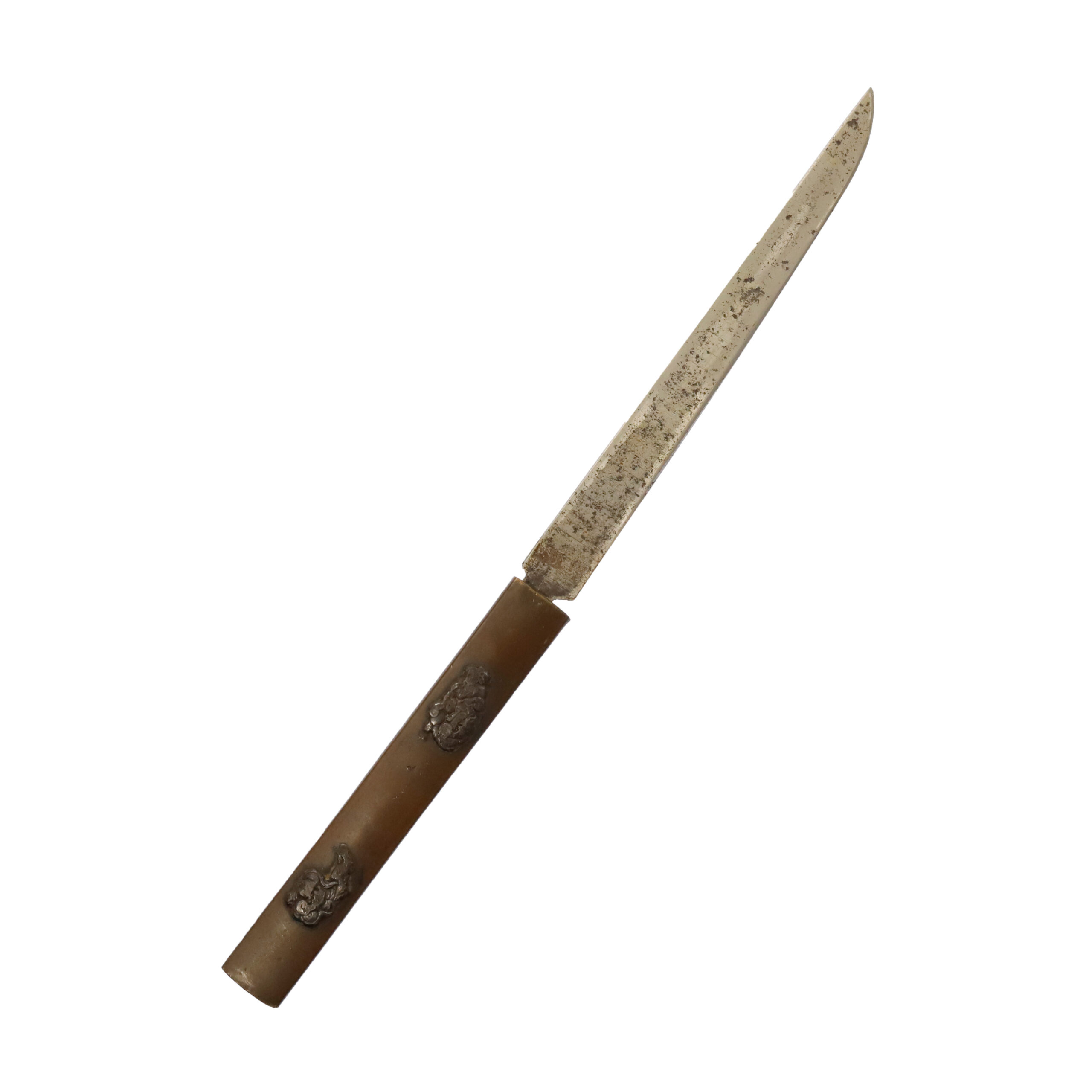
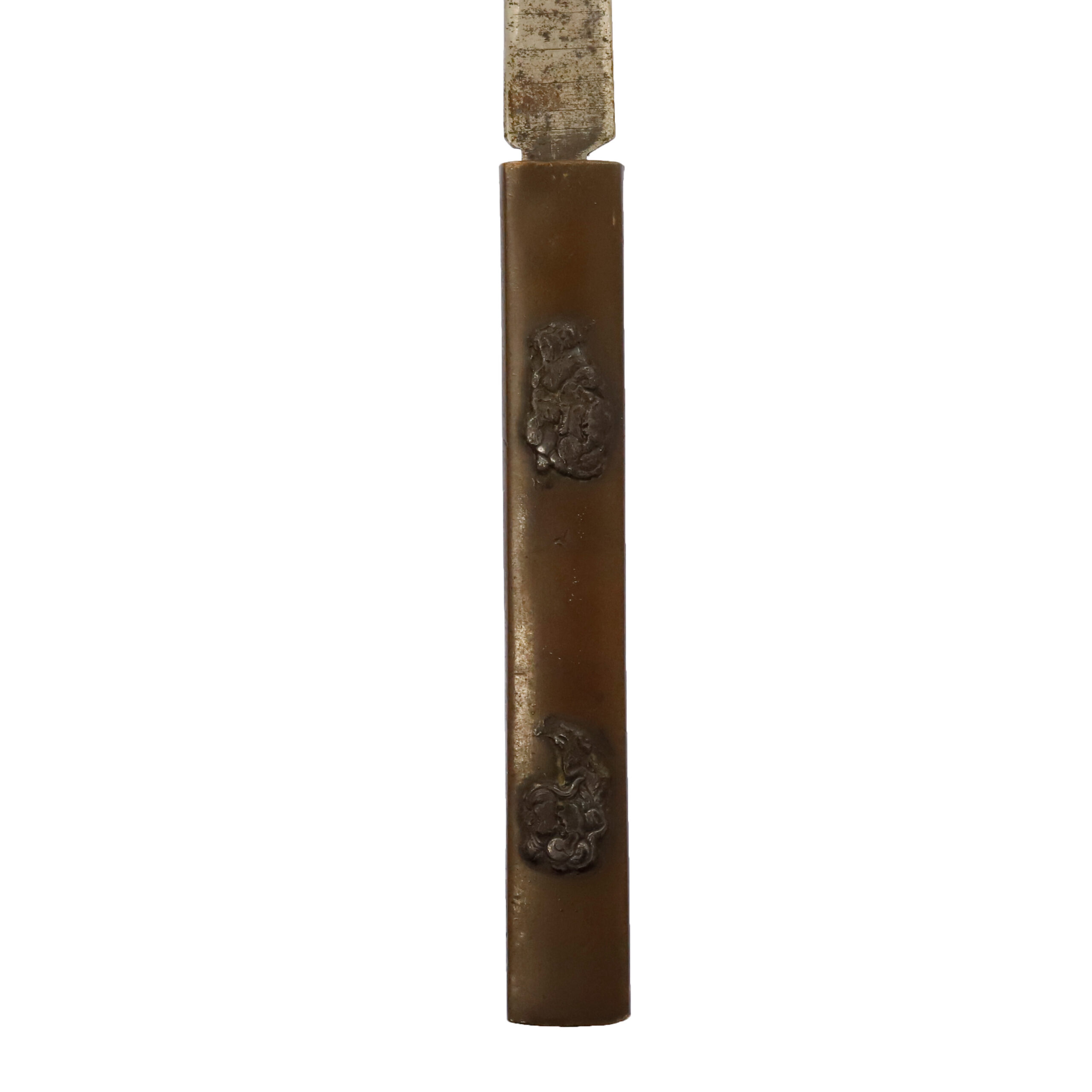
Authentication Paper:NBTHK Tokubetsu Hozon Certificate for the Katana (No.1012076 ) & Hozon Certificate Wakizashi blade (3021964)
NBTHK, also known as Nihon Bijutsu Touken Hozon Kyokai (the Society for the Preservation of the Japan Art Sword), is one of the oldest Japanese sword appraising organizations in modern-day Japan. They authenticated these two blades on August 26th in the first year of (2019). They appraised Katana as a Tokubetsu Hozon Touken and Wakizashi as a Hozon Token, the blade worth preserving for Japanese society. The purchaser will receive these original certificates as well. We can also translate what is written into English and make a PDF file for your record if you request.
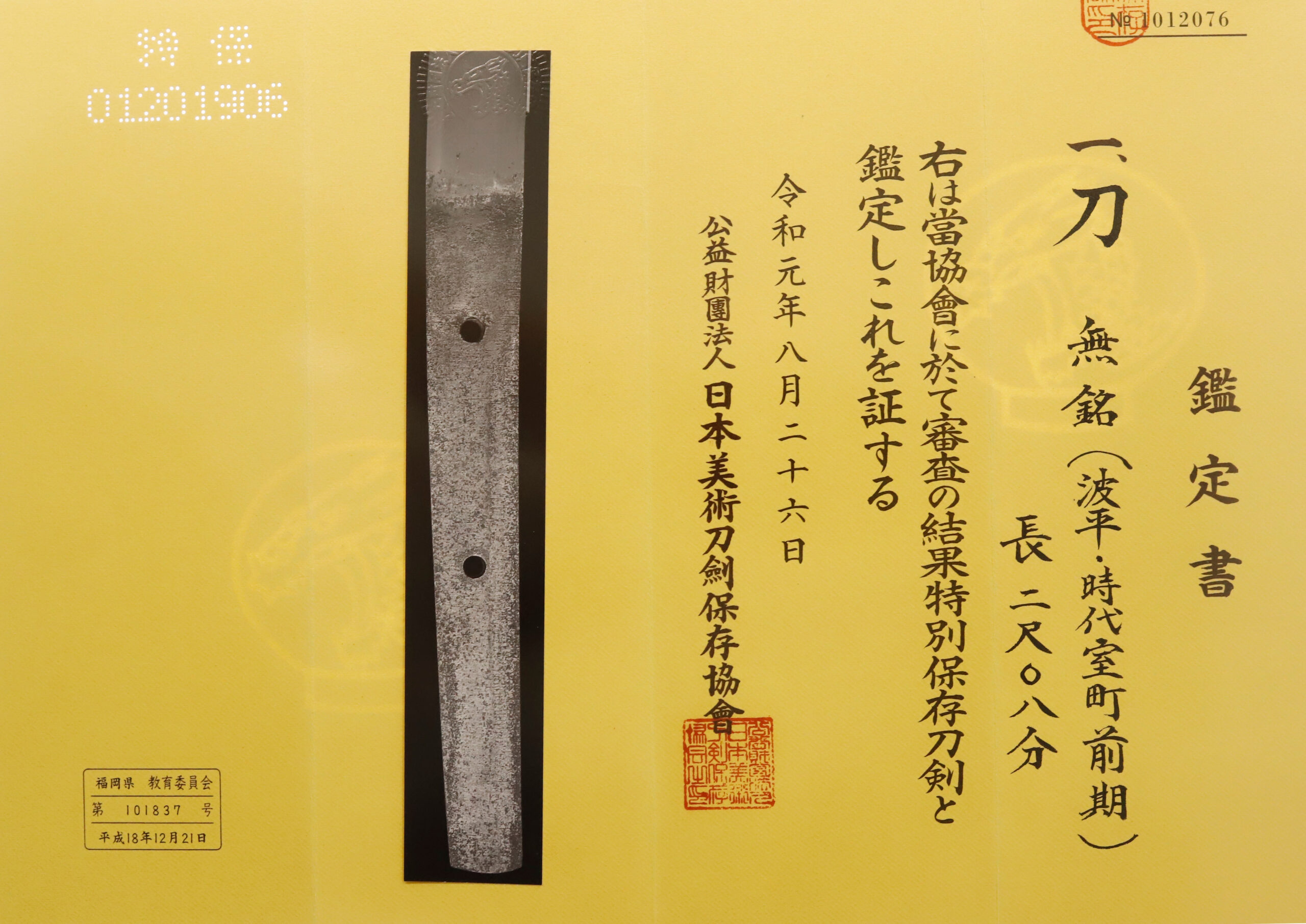
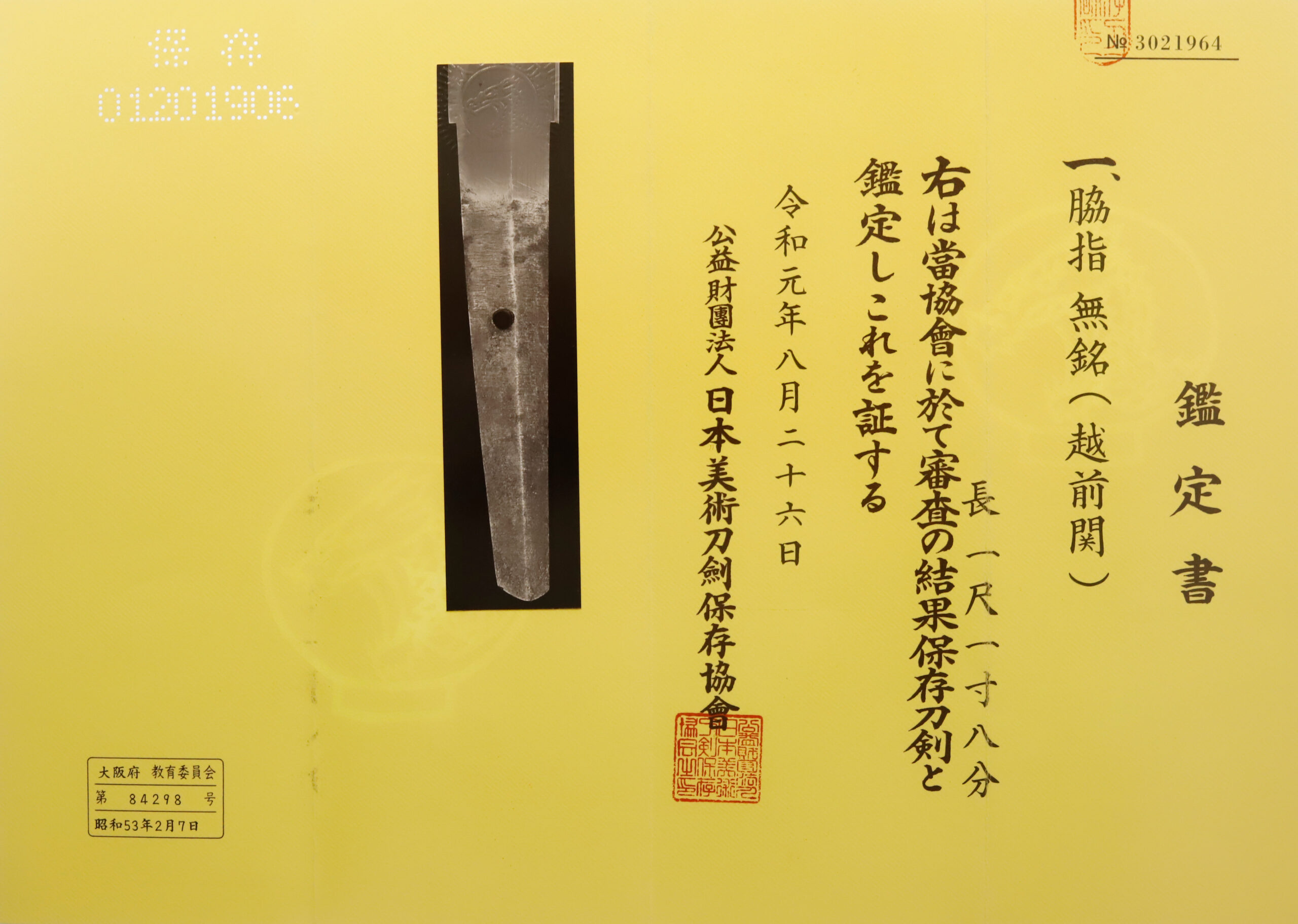
Registration Number : Fukuoka 101837- Osaka 84298
The Board of Education in Fukuoka prefecture issued a registration paper for this Katana blade and Osaka prefecture issued one for this Wakizashi blade . It is called Jyu Token Rui Torokusho(銃刀剣類登録証). Bunkacho(The Agency for Cultural Affairs) acknowledges a Japanese sword with this paper as a work of art.
The sword needs to be traditionally hand-forged and made of Tamahagane carbon steel to be registered in the system. With this paper, its owner in Japan can legally own an authentic Japanese sword. Based on this registration number, we will apply for its export permit.
This paper will need to be returned to the board of education when the sword is being shipped abroad, but you can receive a copy of it. An English translation of this registration paper is available on request.
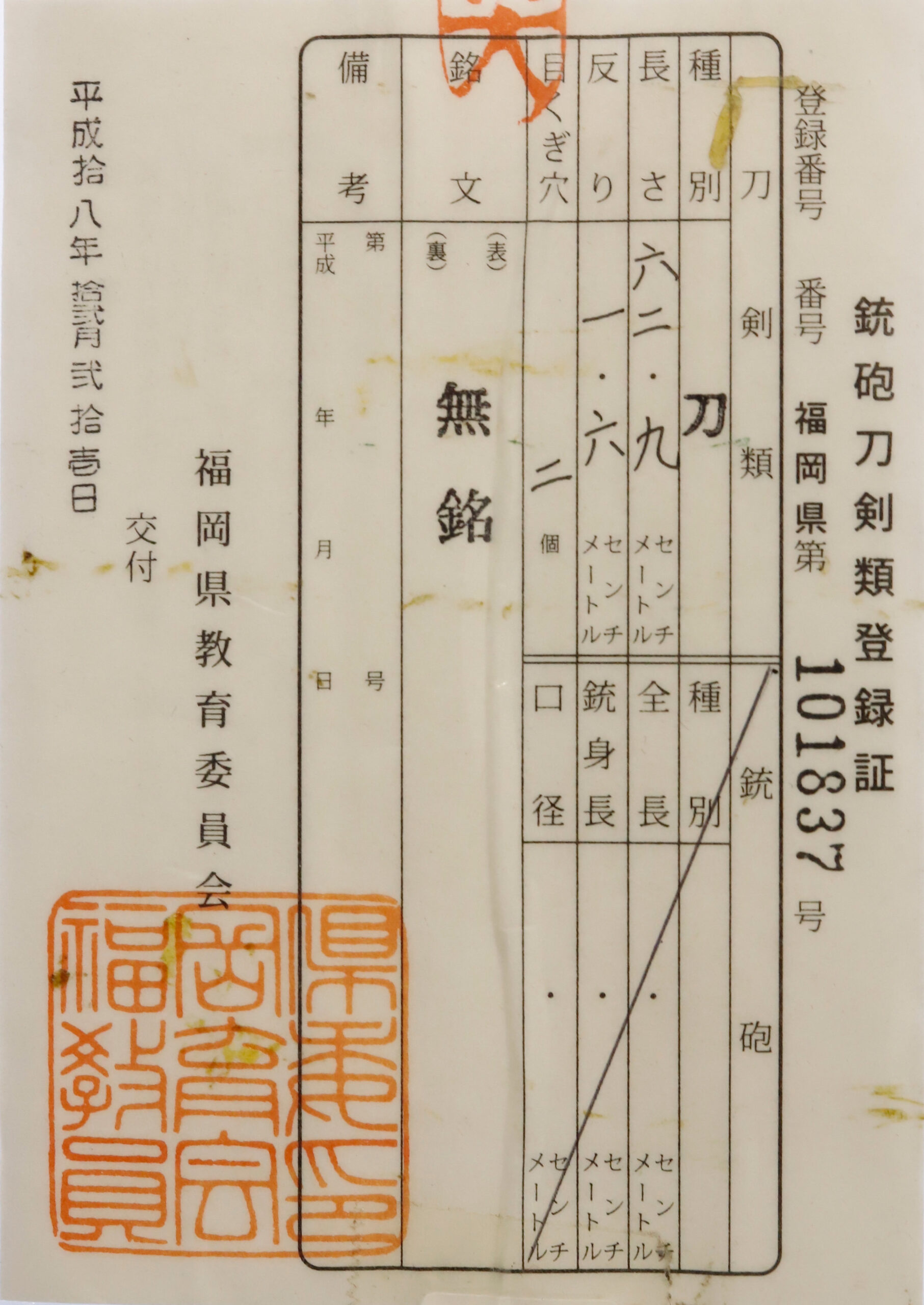
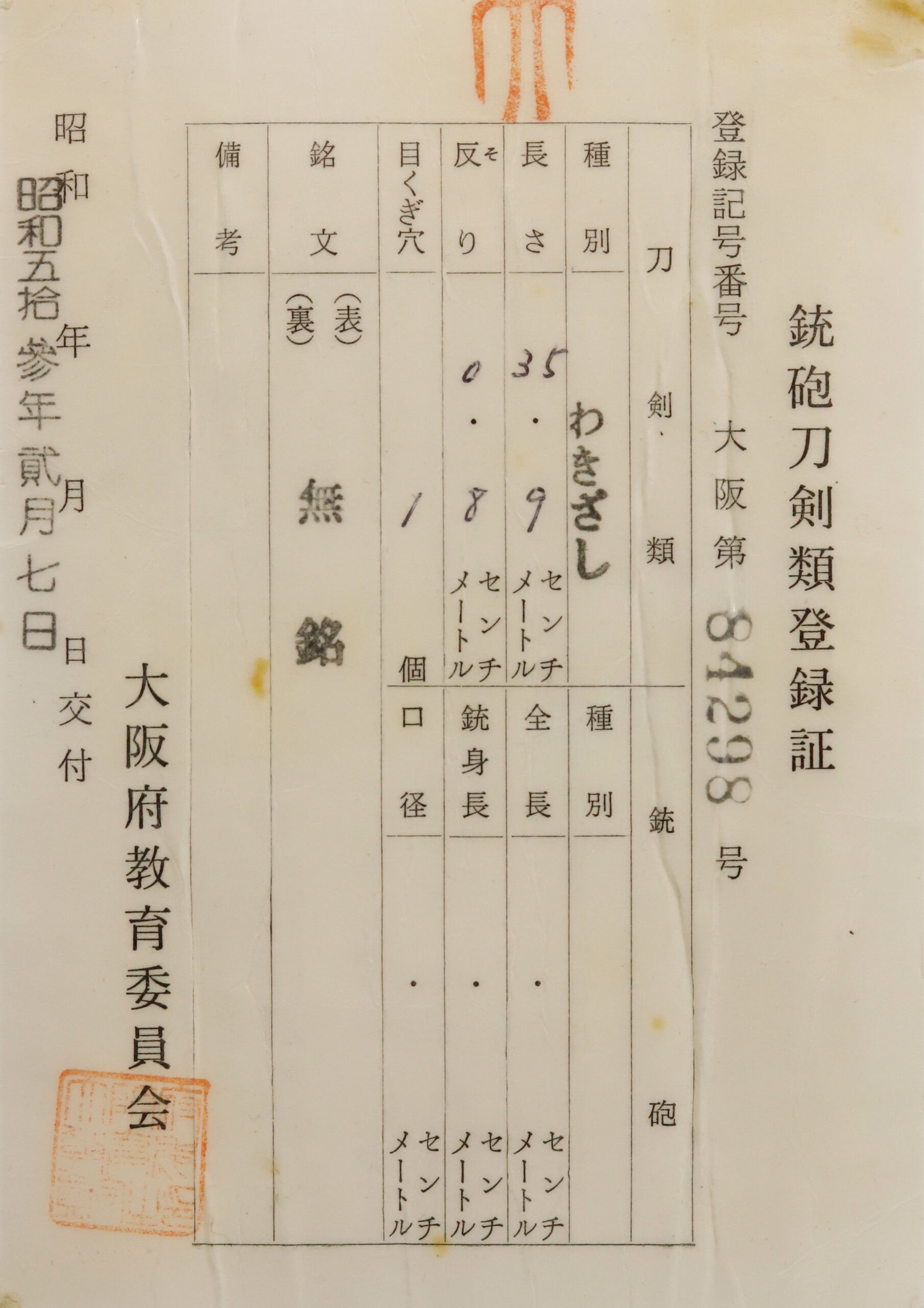

—————————————————————–
【About us】
Samurai Museum is located in Tokyo, Japan, exhibiting antique artifacts related to the Samurai history. Samurai Museum Shop is the place for those who are interested in Japanese culture and craftsmanship. We deal with antique Samurai swords/armor, traditional crafts made in Japan and so on.
【Japanese Sword& Export Process】
The Japanese swords we deal with are hand-forged edged swords made in Japan. It was made from the traditional carbon steel called TAMAHAGANE(玉鋼). Samurai Museum is familiar with the proper legal procedure for an antique/ authentic Japanese sword to be exported from Japan. We have sent more than 500 Japanese swords for the past three years (~2023) to amazing owners who appreciate its historical value.
Each Japanese sword is registered under the Agency for Cultural Affairs and the Board of Education in Japan. They issue a registration paper for each Japanese sword for its owner in Japan to legally possess it. The Japanese sword with its registration paper means it was traditionally hand-forged in Japan.
To legally export the sword from Japan to other countries, we will have to apply for its permit to the Agency for Cultural Affairs(Bunkacho) and return the original registration paper to the Board of Education. It normally takes around 2-4 weeks to receive this permit after submitting required documents. And we would like you to expect at least 1-1.5 months for your order to arrive at your given address after you ordered. For more detailed info, please click here.
It is allowed for residents in Japan to own authentic Japanese swords without a special license as long as they come with registration papers. Please feel free to contact us if you are a resident of Japan, whether temporarily or permanently. We will also assist you when you leave Japan and need to obtain the export permit.
【Payment Method】
We accept payment through Stripe (Credit card), PayPal, Apple Pay or ChromePay, all of which are secure payment methods. Also, you don’t need to make an account on Stripe for the checkout. If you prefer other payment method, please contact us. After confirming your payment, we will apply for an export permit. You may either pay in JPY, USD, AUD, CAD,EUR CHF or GBP. The price is set in Japanese Yen. Prices in other currencies are automatically calculated based on the latest exchange rate.

* If the amount is above 1 million JPY, Stripe or wire transfer will be the only options for payment.
【Shipping】
We have shipped authentic Japanese swords to the USA, UK, Canada, Mexico, Germany, Switzerland, France, Hong Kong and Australia. If you don’t live in these countries and like to order, please contact us first before making a purchase. We offer Free International Shipping as long as we can send antique Japanese swords by EMS.
We normally ship by EMS(Express Mail Service) provided by Japan Post. We will send you a tracking number for your order as soon as we hand it to the post office. We will put 100 % insurance on the shipping document without any extra charge. Based on the total amount, there might be a duty tax or other fee for you to pay, depending on the countries. We use package cushioning to protect the item and put it in a PVC pipe, which is one of the most secure packages because of its durability.
It will normally takes 5-14 days for the item to arrive at your given address after we dispatch it. Time of delivery is estimated as accurately as possible by the carrier but does not take into account any delays beyond our control such as by inclement weather, post office holiday seasons.
* If you live in Australia and like to purchase an authentic Japanese sword, please click here to know the detail.
*Please keep in mind that due to the spread of COVID-19, there might be delays in shipping. If you like to know the detail about shipping, please feel free to ask us.

【Review】
Here is one of the reviews we received from a customer who purchased an authentic Japanese sword from us. For more reviews, please click here.
“My experience overall with the whole process was wonderful. I had many questions about the history and process to purchase these treasures. All my questions were answered very timely and complete. The staff is very knowledgeable and very well versed if any questions do arise.”
【How to make sure the condition】
Please keep in mind that what you are going to purchase is an antique item. We uploaded high resolution photos for you to check its condition thoroughly. If you like to see more photos with different angles, please feel free to contact us. We will be happy to send them to you so that you can make informed decision. It is essential for us to know that you are happy with your choice of a sword. and we are prepared to use the best of our ability to serve you.
【How To Contact Us】
Please contact us through email, Facebook Messenger or Live Chat if you have any questions. You can find each icon on the right side of the website. Please click one of them to reach us. We will reply to you within 1-2 business days.
【The Art of Nihonto (Japanese Sword)】
Samurai’s history is a profound, eloquent legacy of ancient Japanese warriors in which millions of people worldwide are being fascinated. If you like to find out the art of Nihonto, please click here.
【A Guide to Japanese Sword Maintenance】
After acquiring an genuine Japanese sword, it is also important to know how to take good care of it. Here is the special video for you. Mr. Paul Martin, Japanese sword expert, shows you how to give proper maintenance to your sword. By mastering how to clean the Japanese sword, its aesthetic beauty will last forever.
When you purchase a Japanese sword from us, you can get a Free Japanese sword maintenance kit. It comes with four tools(Choji Oil, Uchiko Whetstone Powder, Peg remover, Oil Applicator). By watching the video instruction above , you can enjoy learning how to maintain your Japanese sword while appreciating it. If you have any difficulty assembling the sword or cleaning the blade, you can feel free to contact us.


MORE ANTIQUE JAPANESE SWORD FOR SALE
SWORDS WITHOUT CERTIFICATES FOR SALE
LEARN JAPANESE SWORD TERMINOLOGY
Thank you for reading all the information on the page. If you have any difficulty choosing the right Japanese sword for you, we will be more than happy to help you find the one that speaks to you the most. Please feel free to contact us.
